MG S5 EV Essence 2025 review
In a dramatic turn of events, MG’s appalling ZS EV has been replaced by the all-new, surprisingly excellent, rear-wheel-drive S5 EV – undoubtedly MG’s best car yet
While MG’s combustion-engined models remain in a transitional phase — far less crude than they once were, yet still not competent enough in overall driveability and calibration to deserve genuine praise — the Chinese firm’s EVs have been improving at a rapid pace.
The 2023 MG 4 small car was first, underpinned by a brand new Modular Scalable Platform (MSP) designed solely for electric vehicles, with chassis development and tuning handled by parent company SAIC in conjunction with IDIATA in Spain. And the result was an intelligently designed and keenly responsive small EV with a most un-MG-like dynamic zest and verve.

Now we have MG’s next all-new electric passenger car — the MG S5 EV. Directly replacing the detestable ZS EV, the S5 EV is essentially an MG 4 in small wagon form.
While MG’s marketing says the S5 is a medium SUV (called MGS5 — all hard up — to avoid a copyright lawsuit from Audi), at just 4476mm long, the S5 is effectively a small rear-drive wagon without any pretensions towards being an off-roader, or even a soft-roader.
Offered in two trim levels (Excite and Essence) with two battery sizes (49kWh and 62kWh), MG is adamant that Australia’s S5 line-up will remain that way, despite other variations being offered in other markets, including in right-hand-drive in the UK.

In Blighty, the small-battery S5 is identical to ours but the ‘Long Range’ version gets a 62kWh NCM (Nickel-Cobalt-Manganese) battery, much stronger 170kW/350Nm outputs and WLTP range claims of 465-480km – all of which would make the MG S5 EV even more appealing, and more suitable to Australian conditions.
But what you see here is the best we get for now, and it’s still plenty — the range-topping S5 EV Essence, tested in both 49kWh and 62kWh forms.
What are the MG S5 EV’s features and options for the price?
There isn’t much equipment difference separating the S5 Excite ($40,490 to $44,990 driveaway) and the S5 Essence ($42,990 to $47,990 driveaway).
Visually, they’re virtually identical with the same colour choices, though the Essence adds machine-faced 18-inch alloys (instead of black 17s), a panoramic glass sunroof, a 360-degree camera, auto-fold electric door mirrors, rear privacy glass and a smart electric tailgate.

Inside, the Essence scores rear-seat reading lights, a six-way electric driver’s seat, a heated steering wheel and front seats, vinyl/cloth upholstery (instead of all-cloth), wireless phone charging, a six-speaker stereo (instead of four-speaker) and rain-sensing wipers.
Nearest price competitors to the MG S5 EV Essence include the BYD Atto 3 Premium ($48,319 driveaway in NSW), Kia EV3 Air ($48,990 driveaway), Chery E5 Ultimate ($44,467 driveaway in NSW) and the larger Geely EX5 Inspire ($48,331 driveaway in NSW).
Standard equipment on both MG S5 Essence battery variants includes:
- 18-inch alloy wheels
- LED daytime running lights
- Dual-pane sunroof with electric blind
- Keyless entry
- 10.25-inch driver display
- 12.8-inch infotainment touchscreen
- DAB+ digital radio
- Wireless Apple CarPlay
- Wireless Android Auto
- Wireless phone charging
- Six-way electric driver’s seat with lumbar support
- Heated steering wheel
- MG iSmart app compatibility
- 360-degree camera
- Satellite navigation
- Vehicle-to-load charging functionality (V2L)
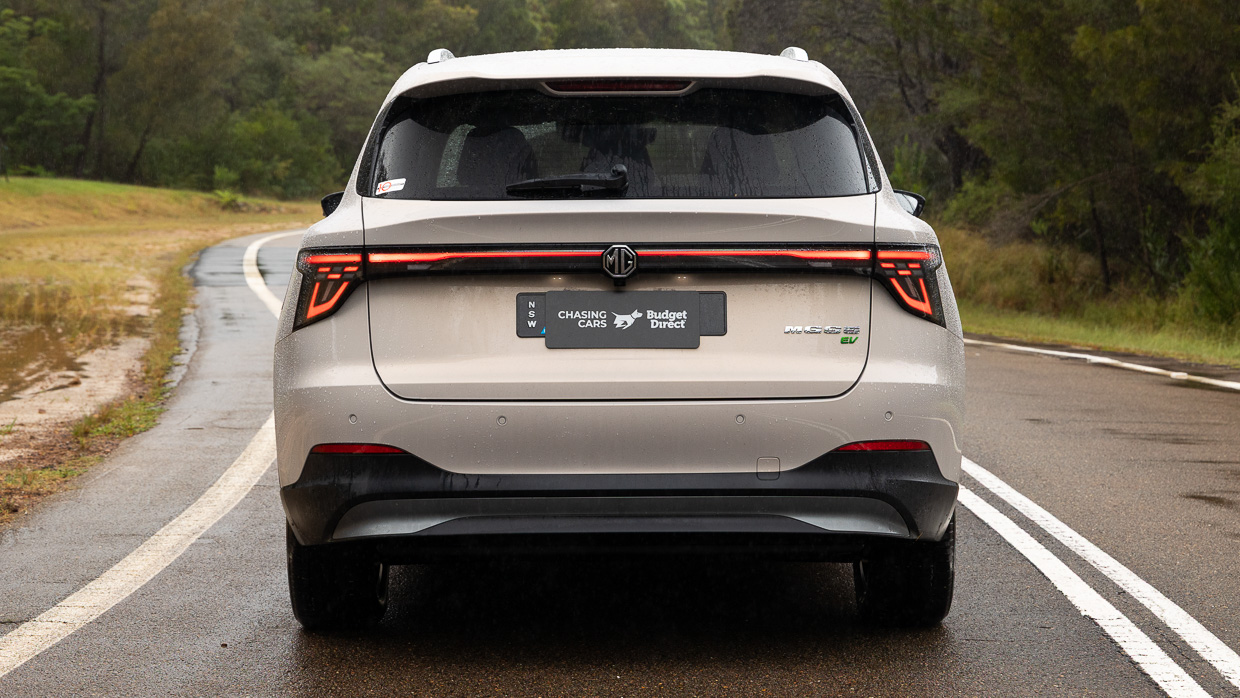
The MG S5 EV is offered in seven colours: Dover White, Sterling Silver metallic, Camden Grey metallic, Champagne Gold metallic, Piccadilly Blue metallic, Diamond Red metallic, and Black Pearl metallic.
How does the MG S5 EV Essence drive?
While the S5 EV is fundamentally the same as an MG 4 underneath, it has been finessed to achieve a more consistent all-round driving experience.
Much of the MG 4’s vertical abruptness over urban road scars has been smoothed away, though the MG S5 remains a firm-riding car with a fairly knobbly around-town ride. It isn’t uncomfortable — just noticeable.
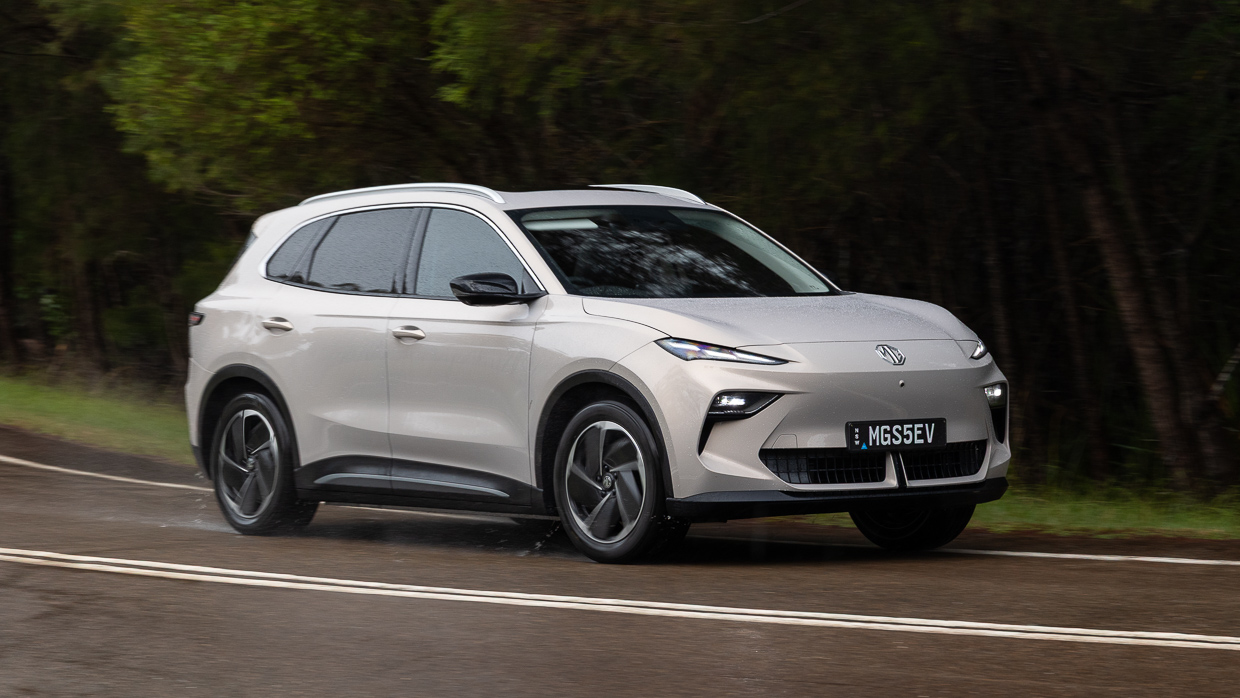
Where this suspension discipline becomes a major advantage for the MG S5 is when you’re pounding over Aussie country roads at highway speeds.
It effortlessly absorbs intrusive lumps and bumps, and demonstrates a genuine affinity for the challenges that our road network can throw up — in complete contrast to the underdamped, deeply flummoxed suspension behaviour of the old ZS EV.
Add the S5’s near 50:50 weight distribution, its crisp and keenly responsive steering, and its rear-drive handling balance and what you end up with is a surprisingly enjoyable and puntable small wagon.
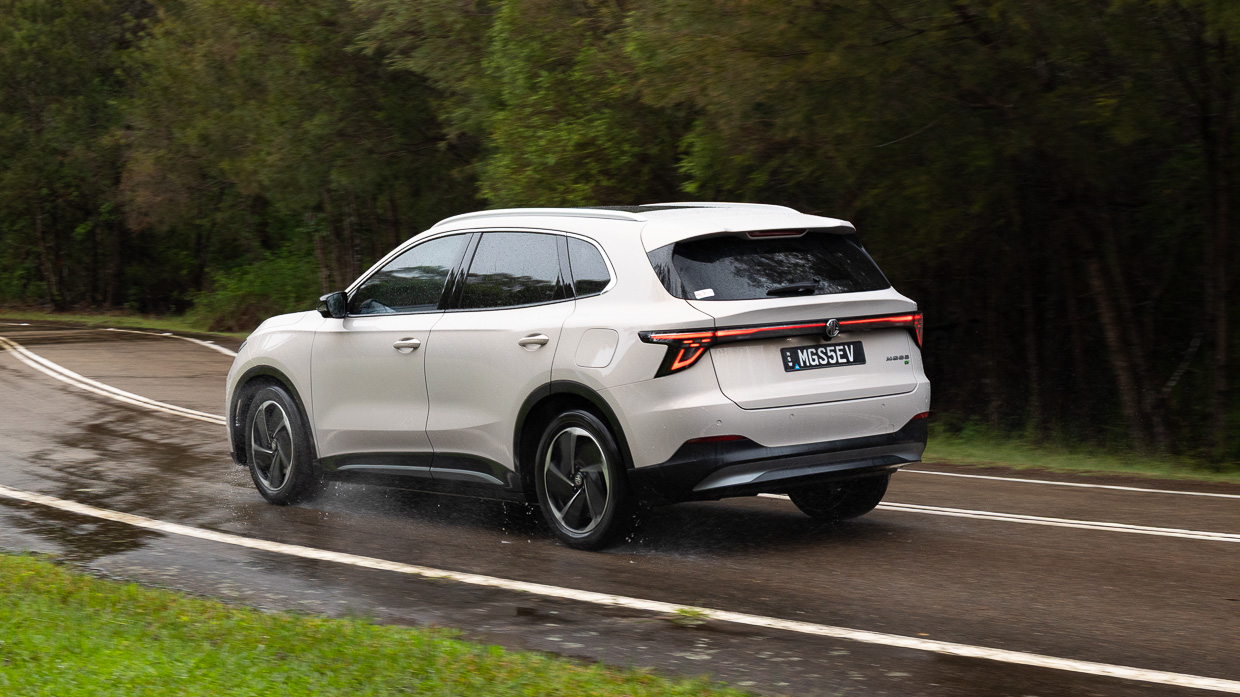
A rare one, too, given that rear-drive wagons of this size vanished with the E46 BMW 3 Series Touring and W204 Mercedes C-Class Estate, both of which have been dead for many years.
Where the MG can’t match those iconic rear-drive German wagons is in the way it breathes with the road. The S5’s stability control is very on its game, quelling any rear-end movement the moment it senses it.
On greasy surfaces or in heavy rain, that’s wonderfully confidence-inspiring, but more nuance in this department would allow the S5 to flow even better.

An ESC Sport mode would be a great idea because the S5’s chassis is both agile enough, and capable enough, to handle a touch more wiggle room. Yet at the same time, it would also hugely benefit from the more powerful 170kW/350Nm powertrain offered in the UK MG S5.
Match those outputs to an ESC Sport tune and the legacy manufacturers would have even more reason to be worried about the Chinese EV invasion.
The Australian MG S5 EV gets 125kW and 250Nm, which is ample for around-town driveability – something the S5 excels at – but doesn’t leave much in reserve for effortless country-road overtaking or brisk standing-start acceleration.
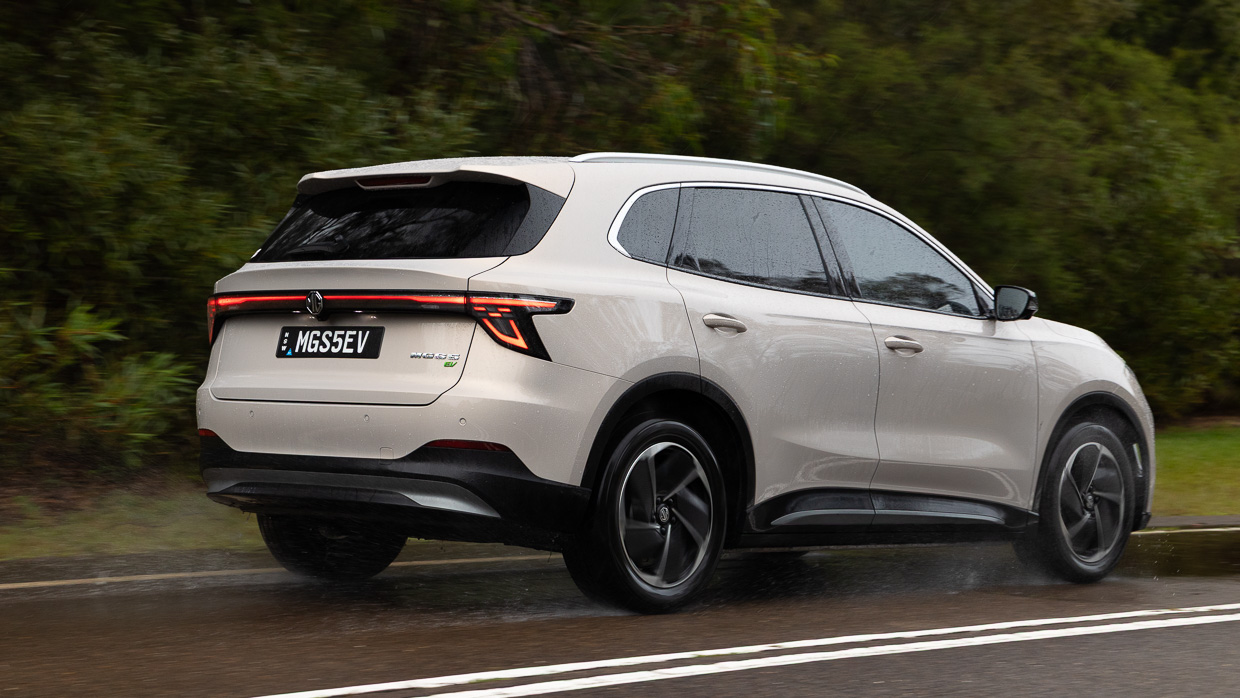
Punched off the line, the S5 almost saunters forward before finally gathering pace, as evidenced by its 8.6sec 0-100km/h claim for the big-battery Essence. In contrast, the UK-spec S5 Trophy does 0-100km/h in a claimed 6.3sec, which would be much better-suited to the MG’s dynamic talents.
Indeed, about the only area where the S5 EV’s driving ability could be criticised is for its not-so-spectacular acceleration. Otherwise, it’s nicely refined and rewarding to drive, with superior regenerative braking performance to the MG 4 — the one-pedal mode finally delivering what its name promises.
What is the MG S5 EV Essence’s interior and tech like?
Apart from its nicely proportioned, attractively inoffensive exterior, what makes the most striking impression about the MG S5 is its lovely interior. Yes, I said lovely.

From its multi-tone colouring to its padded and upholstered front door trims, faux carbonfibre dashboard insert, suede-like covering for the wireless phone charging pad and tweedy cloth seat inserts, there’s a textural warmth in the S5 Essence that elevates it well beyond other MG SUVs such as the mid-sized HS and chintzy new seven-seat QS.
There’s also a cohesive consistency to the way it’s put together, conveying a sense that someone at MG cared enough to shout down any accountant cost-cutting for the S5.

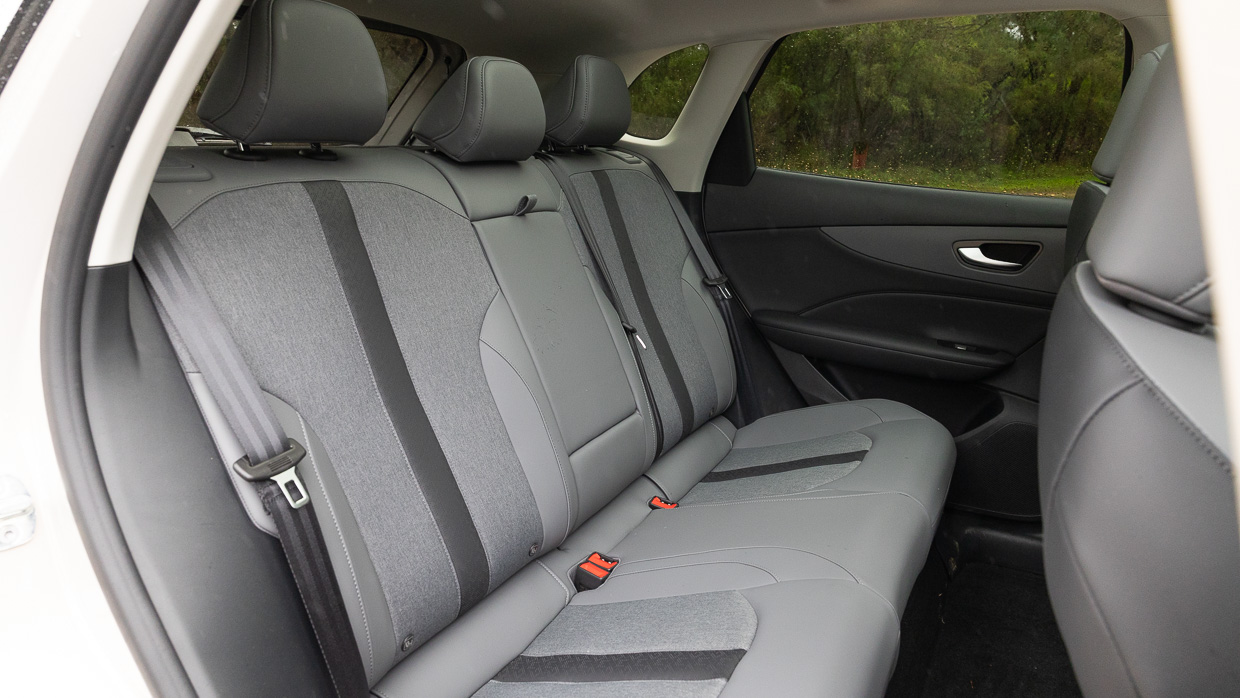
Indeed, the core design is of sufficient quality to easily be conducive to some special-edition treatment in the future. Full colour-coding and Nappa leather upholstery wouldn’t seem out of place in an S5.
But we’re getting ahead of ourselves. As it stands, the sub-$50K Essence strikes a really nice blend between affordable and comfortable.
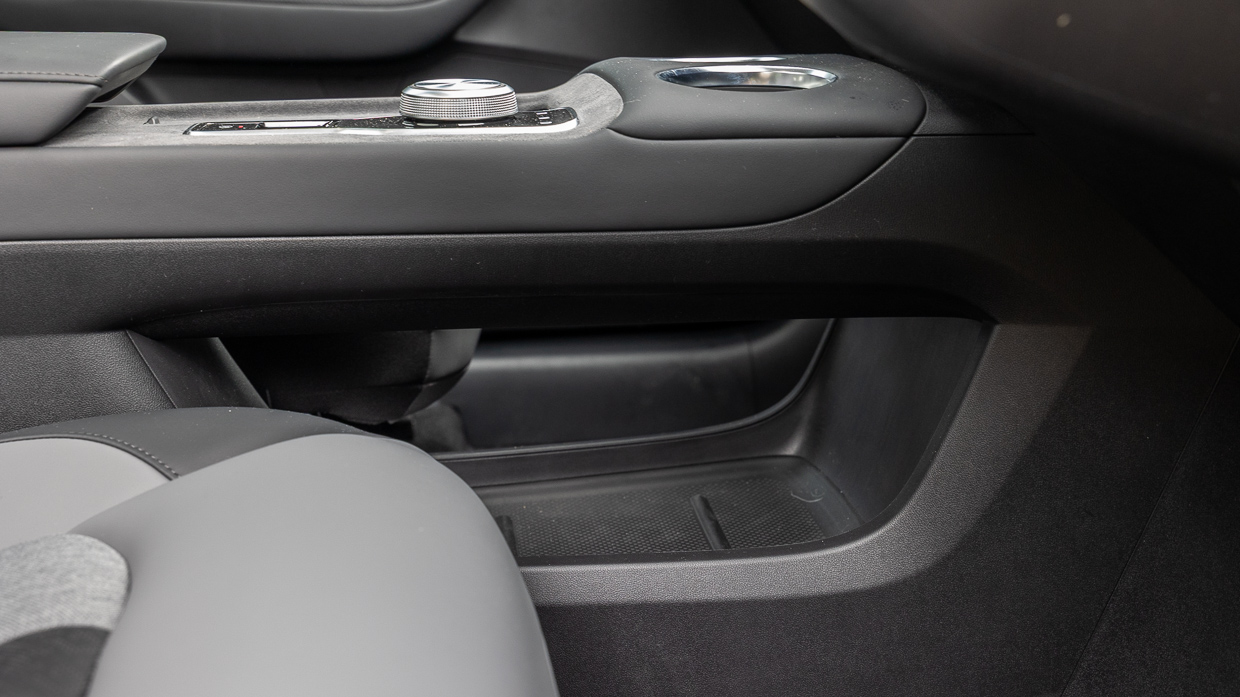
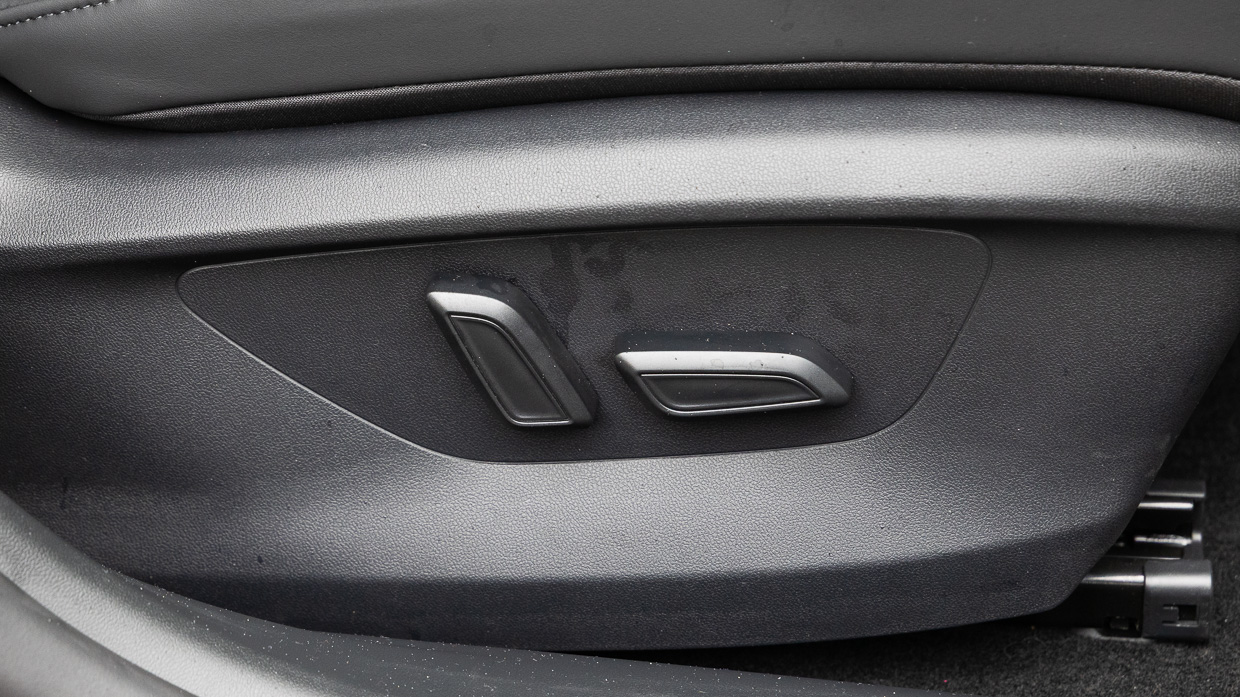
The six-way driver’s seat with proper cloth inserts instead of putrid fake-leather vinyl is impressively supportive — combining with the MG 4’s superb squared-off steering wheel for a great driving position — and so is the front passenger’s seat, despite offering no height adjustment.
The S5’s new metal-look physical switchgear is intelligently designed — replacing screen-embedded HVAC for a proper external set-up — while the all-new 12.8-inch multimedia touchscreen is vastly superior to previous (and existing) MG systems for processing speed, overall clarity and ease of use.

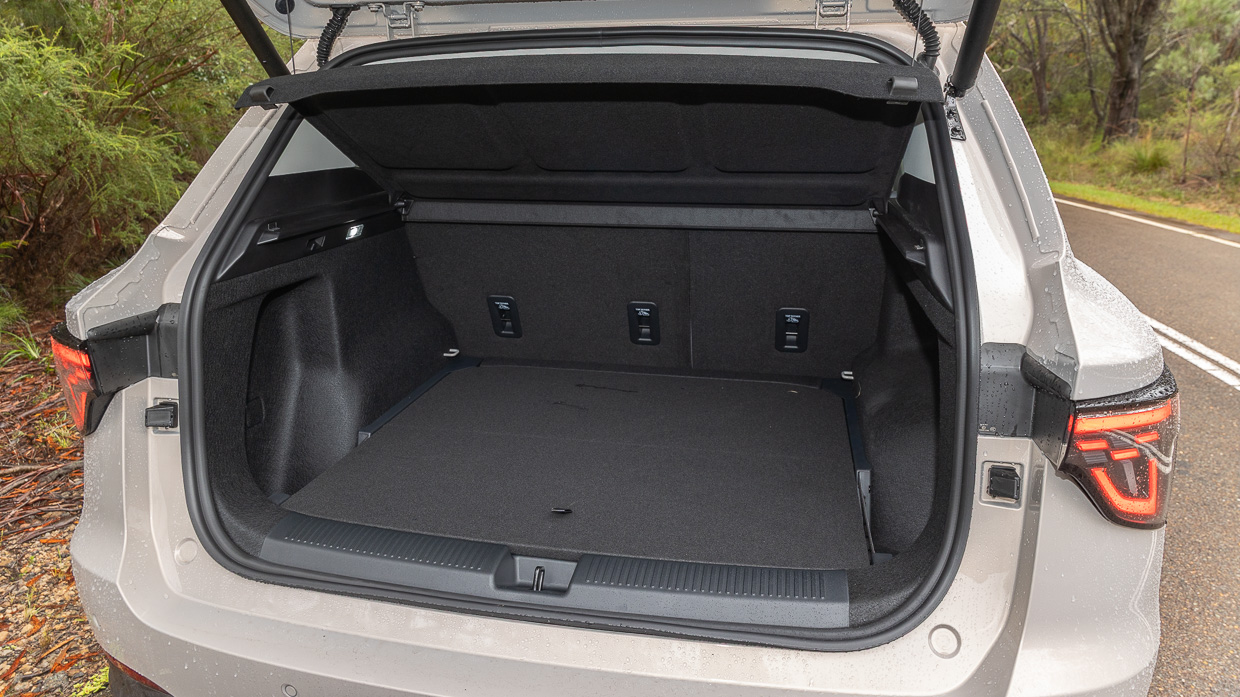
The wireless Apple CarPlay and Android Auto are simple to connect, and (mostly) reliable in their connectivity, while the six-speaker stereo is acceptably strong, if rather digital in its sound production.
With a completely flat floor, the S5’s rear seat is agreeably large, with a deep cushion and tonnes of vision through the panoramic roof, if not headroom for over six-footers. There’s also ample door storage front and rear — as well as proper hand grips in the front — plus a reasonably flexible 453-litre boot accessed via an electric tailgate.
Is the MG S5 EV Essence a safe car?
The MG S5 EV recently received a five-star ANCAP rating for its crash-test performance and its available electronic active-safety features.
Individually, the S5 scored 90 percent for adult occupant protection, 86 percent for child occupant protection, 82 percent for vulnerable road user protection, and 79 percent for its safety-assist systems.

Standard safety equipment on the 2025 MG S5 EV Essence includes:
- Seven airbags
- Adaptive cruise control
- Lane-keep assistance
- Forward cross-traffic alert
- Front AEB with forward collision warning
- Lane-departure warning
- Emergency lane-keep assist
- Driver attention monitoring
- Speed-limit assist
- Blind-spot detection
- Rear collision alert
- Rear cross-traffic alert
- Rear cross-traffic AEB
- Rear parking sensors
- 360-degree camera
- Tyre-pressure monitoring
- MG Pilot Custom mode
Unlike most previous MGs, the S5’s active-safety systems are much more nuanced in their operation, with a finessed approach to intervening, meaning less severe intrusion.
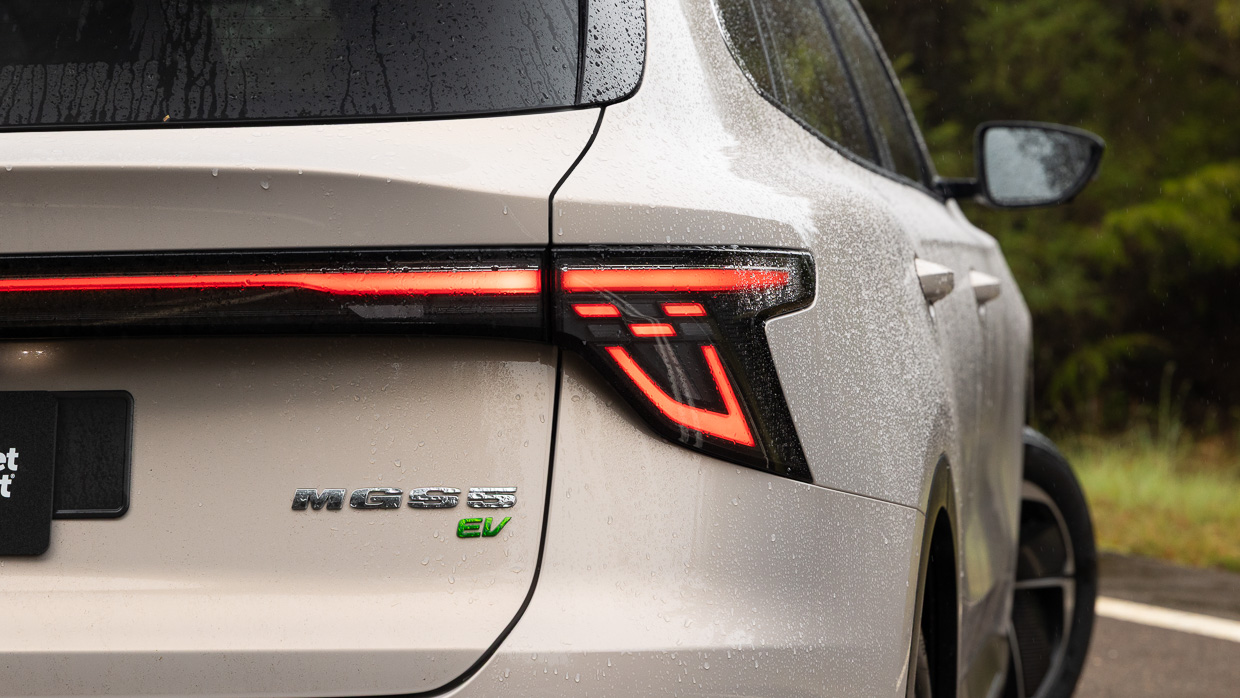
Yet the S5 Essence also includes a new MG Pilot Custom mode, which allows you to save your desired active-safety settings into one button, and it remembers your selection next time you start the car.
In 2025, this feature is a game-changer — preventing irritating driver distraction from intrusive active-safety ‘assistance’.
What are the MG S5 EV Essence’s ownership costs?
The official WLTP range claim for the big-battery MG S5 EV Essence 62 is 425km, compared to just 335km WLTP for the smaller-battery Essence 49.
While those WLTP distances aren’t huge, they’re directly comparable to the range claims of the S5’s chief price competitors: BYD Atto 3 Premium (420km), Kia EV3 Air Standard Range (436km), Geely EX5 Inspire (410km), and Chery E5 Ultimate (430km).

Using a DC ultra-fast charger, the MG S5’s 10 to 80 percent charging time is a respectable 28 minutes — significantly faster than all its rivals bar the Kia EV3 — with a maximum DC rate of 120kW for the Essence 49, and 150kW for the Essence 62.
Recommended service intervals are every 12 months or 25,000km, with the MG’s five-year/125,000km servicing cost being $1967.
MG’s new-vehicle warranty in Australia recently changed to seven years/unlimited kilometres for private buyers, which can be stepped up to 10 years/250,000 kilometres if serviced on time at an MG dealership. Roadside Assistance is included within the warranty period.
MG additionally offers a seven year/150,000 kilometres battery warranty.
The honest verdict on the MG S5 EV Essence
If you’re familiar with the MG 4 and enjoy what it brings to the table — particularly its driver appeal — then you’ll probably love the S5 EV.
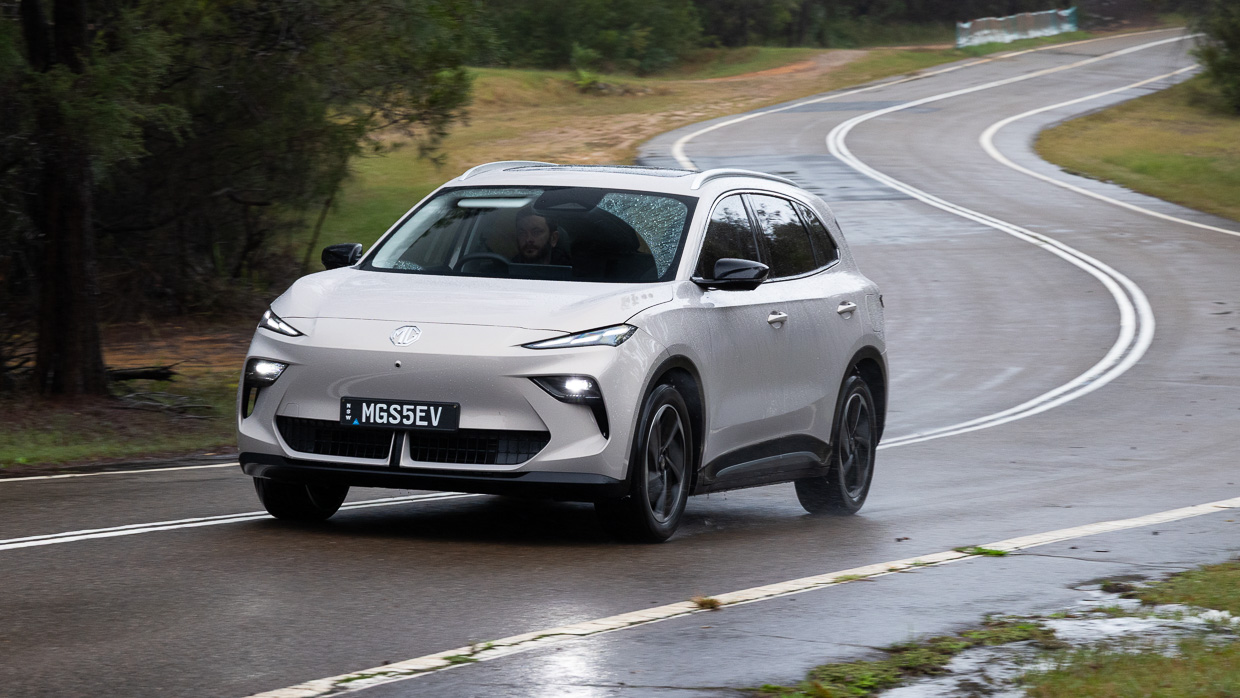
It’s a more refined, more practical and more comfortable MG 4 that doesn’t lose out when it comes to dynamic enjoyment, especially when it comes to steering response.
Yet it’s the MG S5’s interior that makes this cost-focused EV feel so enriching. Aside from the Cyberster, this is the first modern MG to look and feel like more than the sum of its parts.
Roomy, comfy, nicely built and tastefully trimmed, it transcends the superficial hollowness that permeates most non-premium Chinese cars, including MG’s chintzy seven-seat QS SUV.
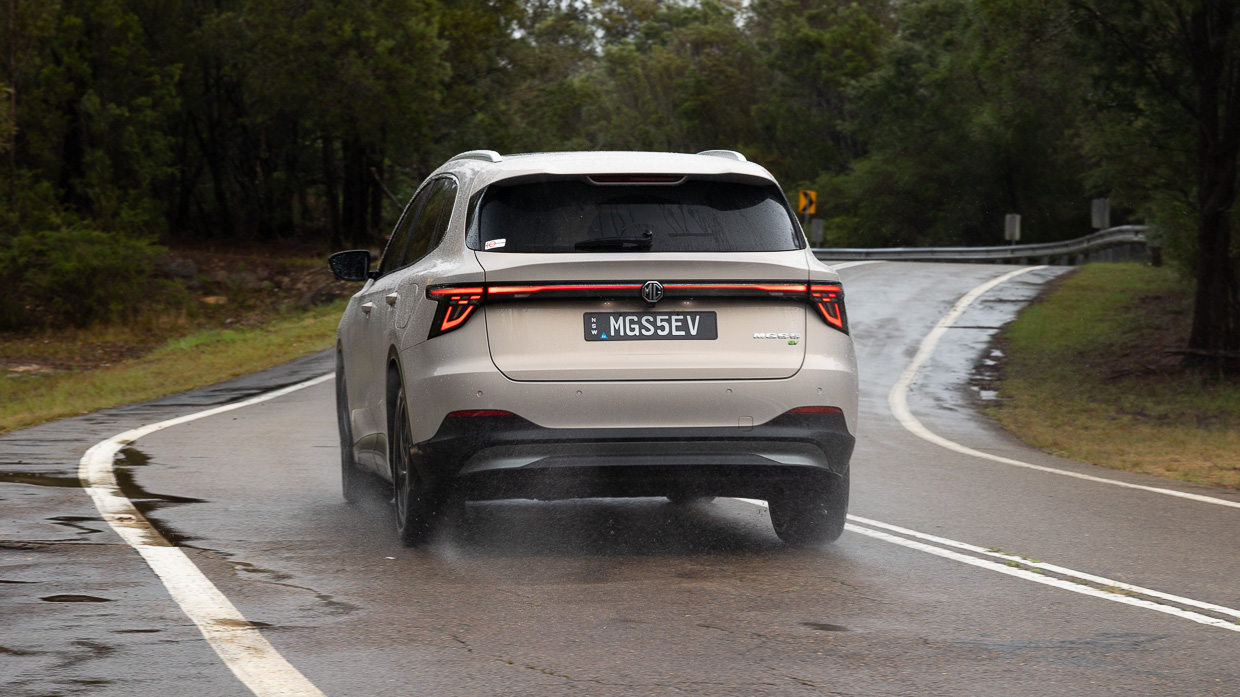
With the grunt (and the extra range) of the 170kW powertrain offered elsewhere, the S5 would be even more of a winner. But as it stands, the top-spec 125kW Essence remains a surprisingly impressive small electric rear-drive wagon for less than $50K driveaway.
Given the extra equipment you get, the Essence is a smarter buy than the cheaper Excite. And for the extra range, the larger-battery 62 is a more intelligent option than the 49 – especially if you venture beyond the city.
Mini Countryman SE 2025 review
3 months ago

The eccentric, electric Countryman is armed with enough practicality to lure even the most sensible of buyers
Good points
- Solid value for money
- Joyful interior design
- Bloody quick
- Fun, comfortable dynamics
- Does ‘different’ well
Needs work
- Still expensive outright
- Interior isn’t family friendly
- Range isn’t impressive
- No spare tyre
- Slow DC charging
The electric age is a transition that seems almost custom-made for Mini.
Small cars and SUVs are some of the easiest to convert into electric vehicles as they often only travel short distances, generally don’t carry many people and recoup a significant amount of energy in city-style stop-start driving.
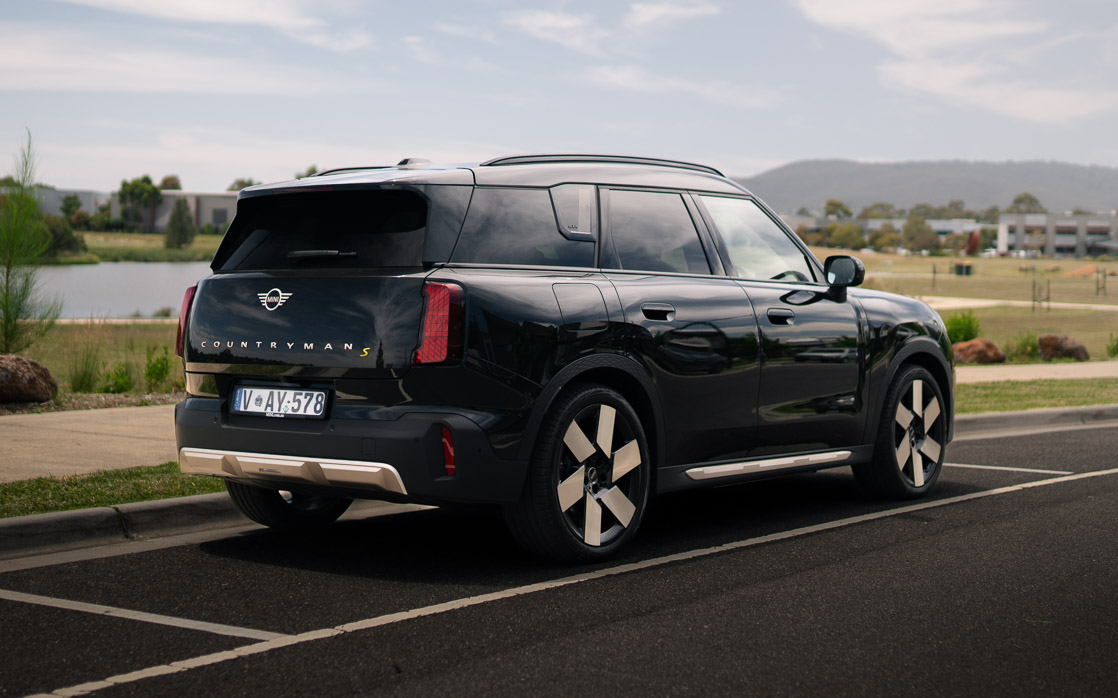
Yet Mini isn’t putting all its eggs in one basket, offering the increasingly important new-gen Countyman in petrol and electric guises, just like the Cooper small hatch.
Following the related and generally impressive BMW iX1 to market, Mini’s new-generation Countryman arrives with a more practical interior and surprisingly accessible price tag.
These attributes saw the Countryman go further than expected in our Car of the Year coverage, easily earning its stripes. Impressively, it was the electric SE version — rather than the petrol variant — we have on test that made the biggest splash.

So, has the Countryman transcended its niche status as a fun and charming small SUV into something a pragmatic buyer should actually consider?
What are the Countryman SE’s features and options for the price?
The electric Mini Countryman range is offered in front-drive single, and twin-motor all-wheel-drive variants, known as the E and SE, respectively.
Both feature a NCM 64.6kWh usable battery size and the less punchy E starts at $67,990, before on-road costs, with a greater range of 462km (WLTP). The SE opens at $72,990 with an extra 70kW and nearly twice the torque, though its quoted driving range falls to 432km.
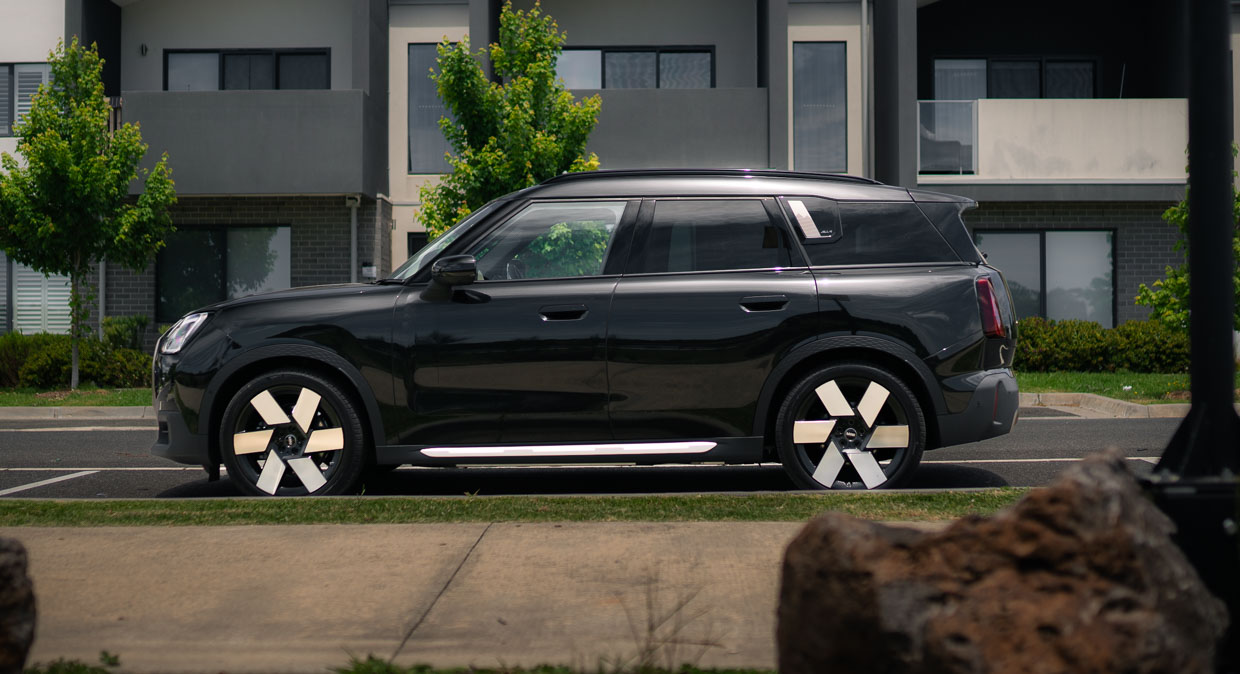
Each are offered in three sub-trim levels, with the SE starting with the Classic, moving to Favoured you see here and then headline JCW Sport trim — not to be confused with a true JCW offering.
For about $3000 more than the Classic, the Favoured offers a few meaningful upgrades, including larger and more stylish 19/20-inch wheel options rather than the Classic’s 18s, a lovely Harman Kardon sound system and electric front seat adjustment.
It’s a trade-off we think is more than worth it for the price, but the JCW Sport trim above it is less enticing. Aside from the addition of high-performance brakes, the changes are simply cosmetic and will come down to personal taste.
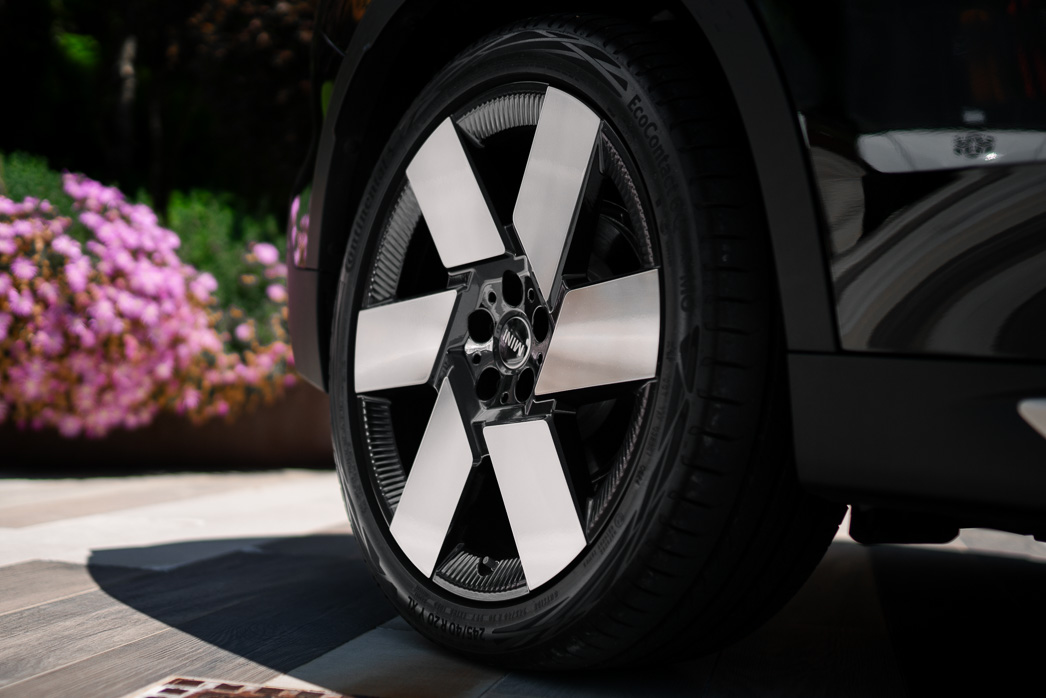
Below are some of the Favoured’s notable features:
- LED headlights
- Panoramic glass roof
- 240mm circular OLED touchscreen
- Digital instrument display
- Head-up display
- Interior camera
- Augmented reality navigation
- Mini connected services
- 12-speaker, 365-watt Harman/Kardon premium sound system,
- Wireless Apple CarPlay and Android Auto
- Wireless phone charging
- Automatic Tailgate with kick function
- Dual-zone air conditioning with rear ventilation
- Electric front seat adjustment with driver massage function
- Front JCW Seats with seat heating
- Sun protection glazing
The list price of $75,990 for the Favoured is significantly cheaper than the related BMW iX1 xDrive30 ($86,800) or equivalent Mercedes-Benz GLA 350 4Matic ($102,900). If you step up in size in a mainstream rival, like a Hyundai Ioniq 5 long-range RWD model ($75,800), you’ll find yourself with less equipment and verve than the Mini.

The closest match we can find for an AWD-equipped model that doesn’t hail from China is the Subaru Solterra Touring at $76,990, but the smaller Mini is levels more complete in equipment and execution.
But the options shipped in from China are not to be ignored; with the Zeekr X AWD ($64,900), Volvo EX30 AWD ($71,290) and EX40 ($81,990) small SUVs, along with the Smart #1 Brabus ($67,900), all now available to Aussie buyers. While not a segment rival, the popular, larger Tesla Model Y (Long Range AWD, $68,900) is never for from any electric SUV conversation.
What is the Countryman SE’s interior and tech like?
Minimal interiors are all the rage in 2025, but Mini has been doing this since many of its customers were scooting toy cars across the carpet.
Perhaps that’s why Mini is so good at it.
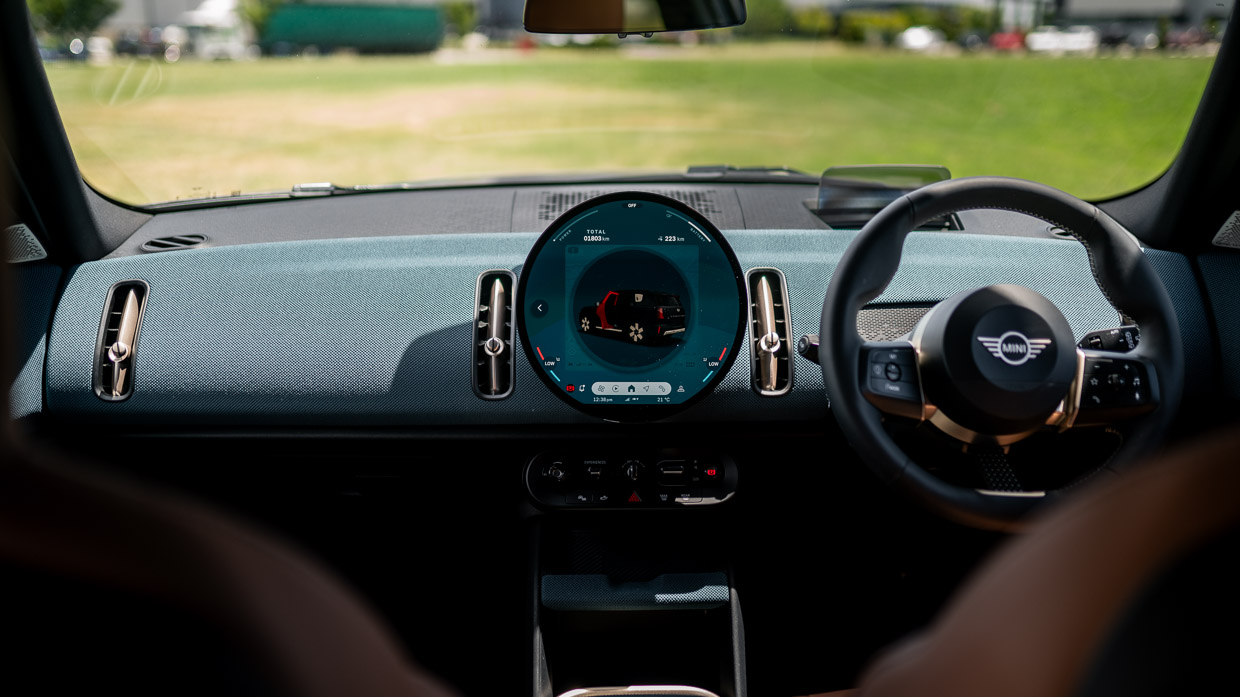

The niche brand has been harking back to its heritage with a ‘circular’ central display for years, but with Mini’s latest products, the touchscreen now proudly occupies all 240mm diameter of circular real estate with a crisp OLED screen that serves as the overall command centre.
Showing its practiced hand in this area, there is limited glare in the harsh Aussie sun, and it’s matched with a sharp head-up display so drivers aren’t constantly taking their eyes off the road — like in, say, a Tesla Model Y.
Mini’s software presents a steeper learning curve than some, with a large amount of information and options presented at all times. After spending more time with the Countryman, the efficiency of this layout becomes clearer, though.
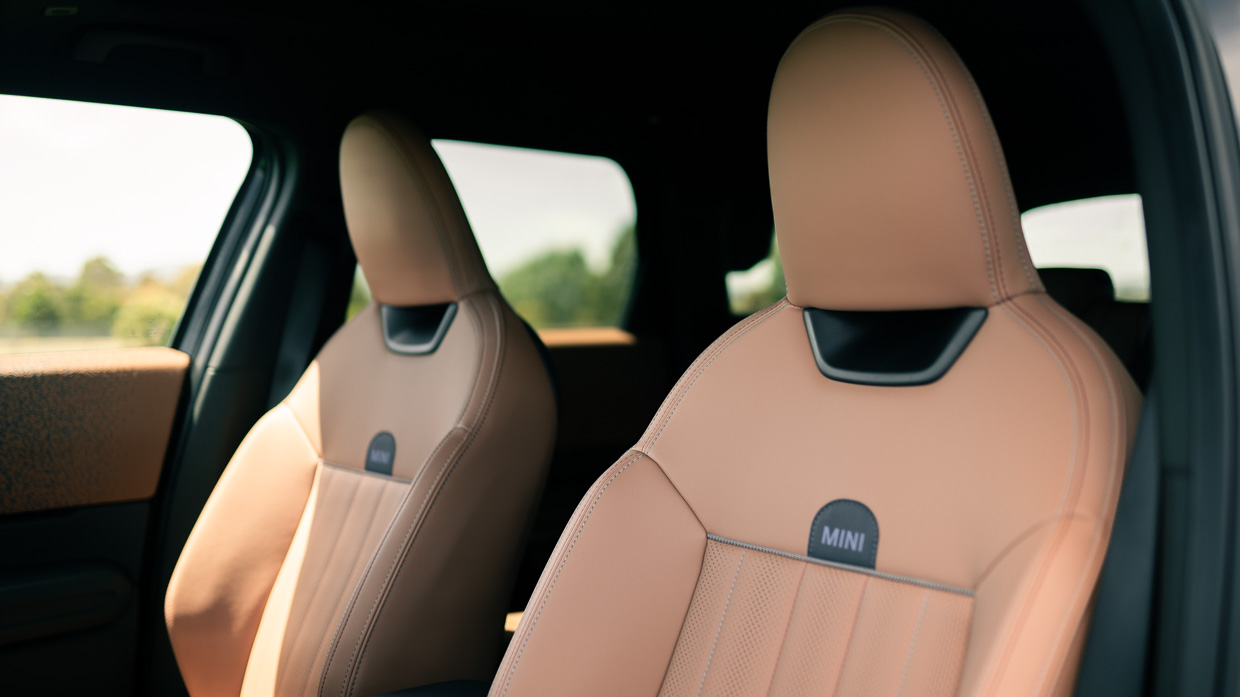
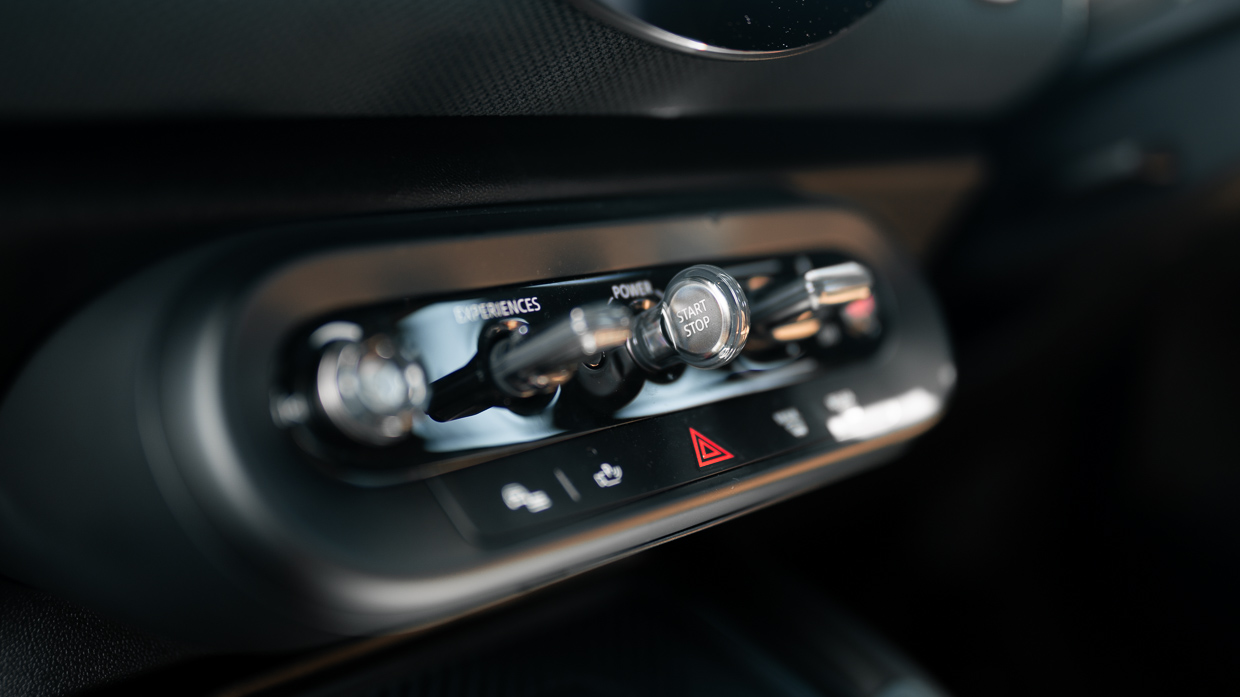
The theatre of the design is the star, with a series of joyful toggles and switches below the screen that cycle through the drive modes, called ‘Experiences’, that affect the display theme, multimedia sound profile and even the driving experience with options such as “Go Kart Mode”.
Dancing on the edge of being a gimmick, the fun modes were a delightful touch that appealed to the Chasing Cars team.
One key reason to upgrade to the Favoured trim is the 12-speaker Harmon Kardon which offers remarkable clarity and depth in the Countryman’s cabin. It combines well with the hushed drivetrain and decent sound deadening to make comprehensible, low-volume listening at highway speeds a reality.
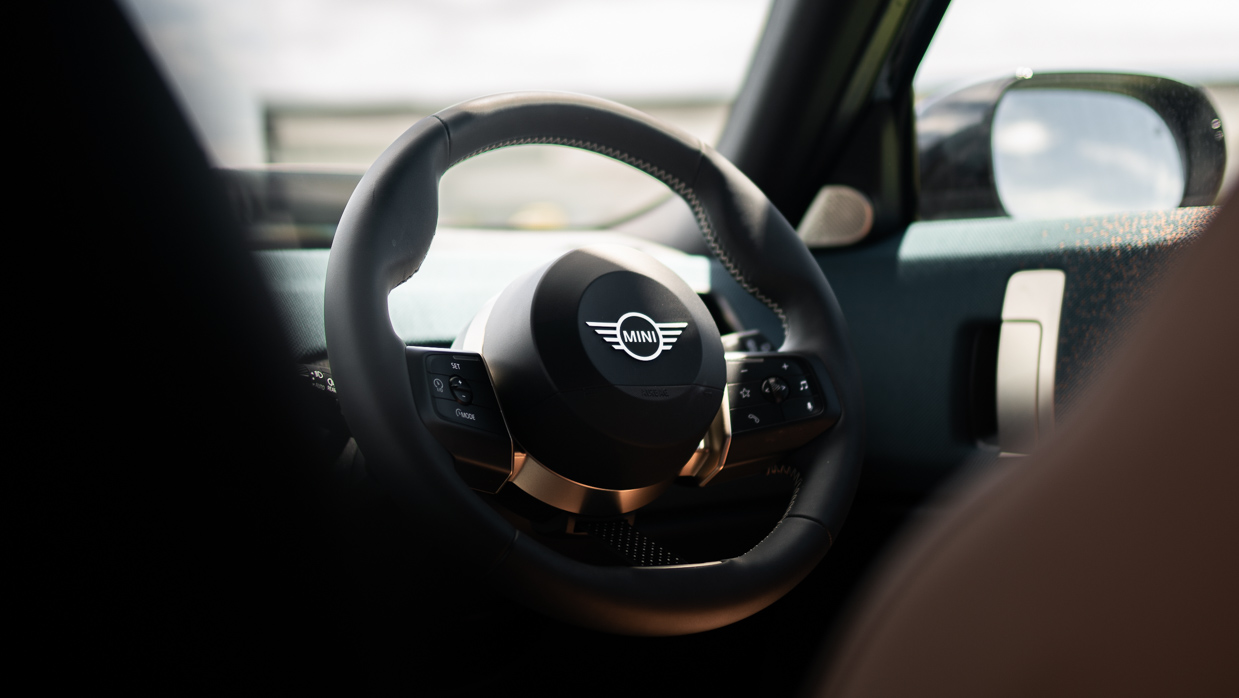

On a more practical note, the seats themselves are firm but supportive and generally comfortable, with enough room in the default position to accommodate my leggy frame at 182cm tall.
Despite a litany of nooks and crannies about the cabin, incidental storage feels a bit lacking, as many areas are too small or oddly shaped to stow items without a bit of Tetris action.
Moving to the second row, there is still plenty of space to seat an adult, even behind my own driving position.
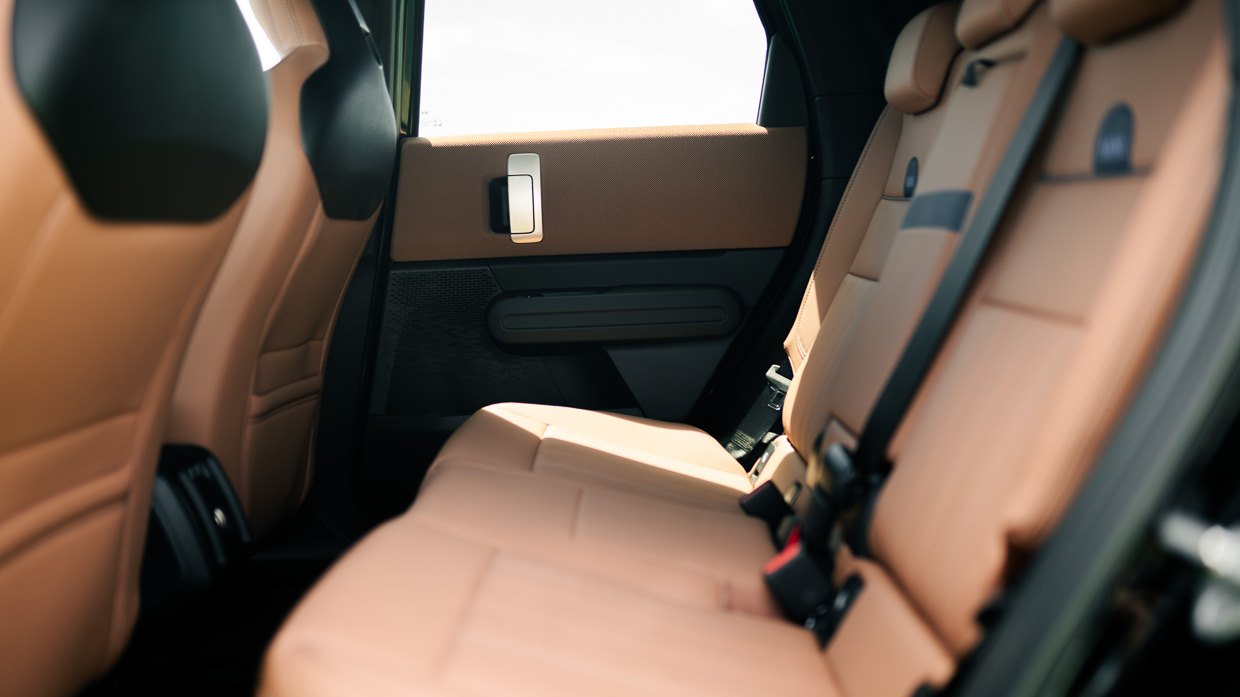
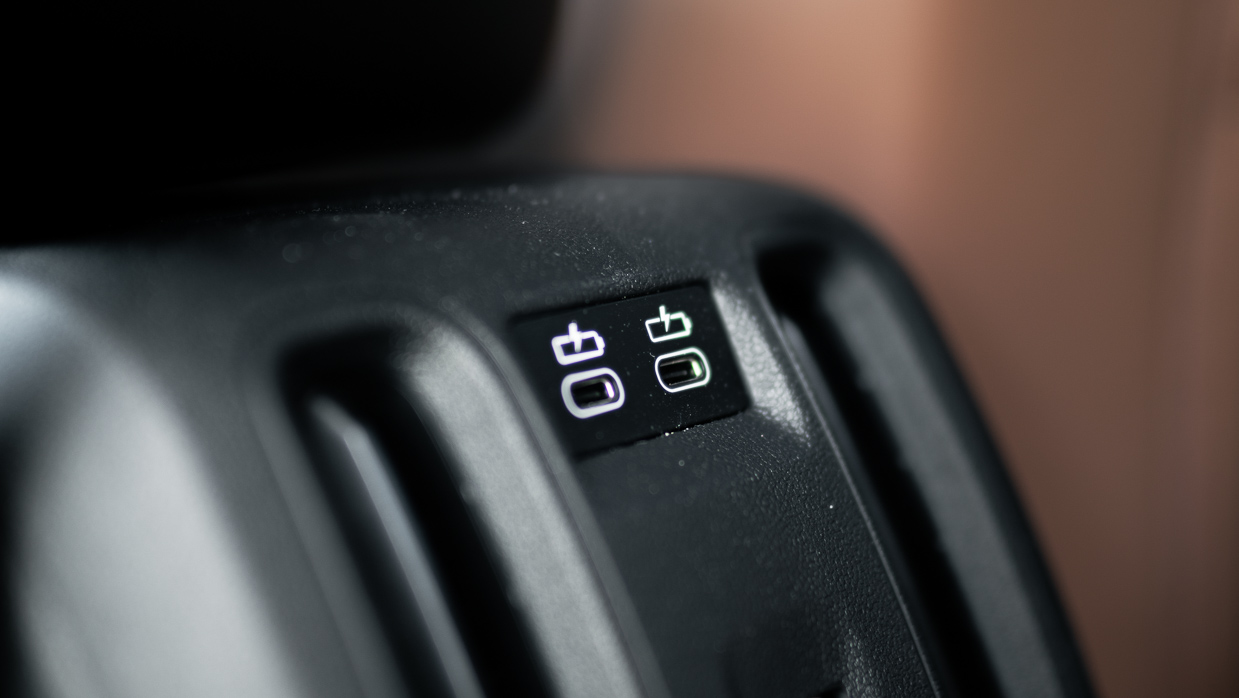
There’s even enough room to fit a rear-facing baby seat, which would have been impossible in small SUVs only a few years ago. The Countryman, like many others, has not only grown, but also matured in its packaging to the point that it can genuinely serve as a family vehicle.
The tops of the interior door cards are trimmed with a wonderful wool-knit style material which is nice to look at, if a bit abrasive to touch. Though, as a parent, a child rubbing a smuggled-in against the cheese-grater-like texture was a constant worry.
Kid-friendly, this material is not.
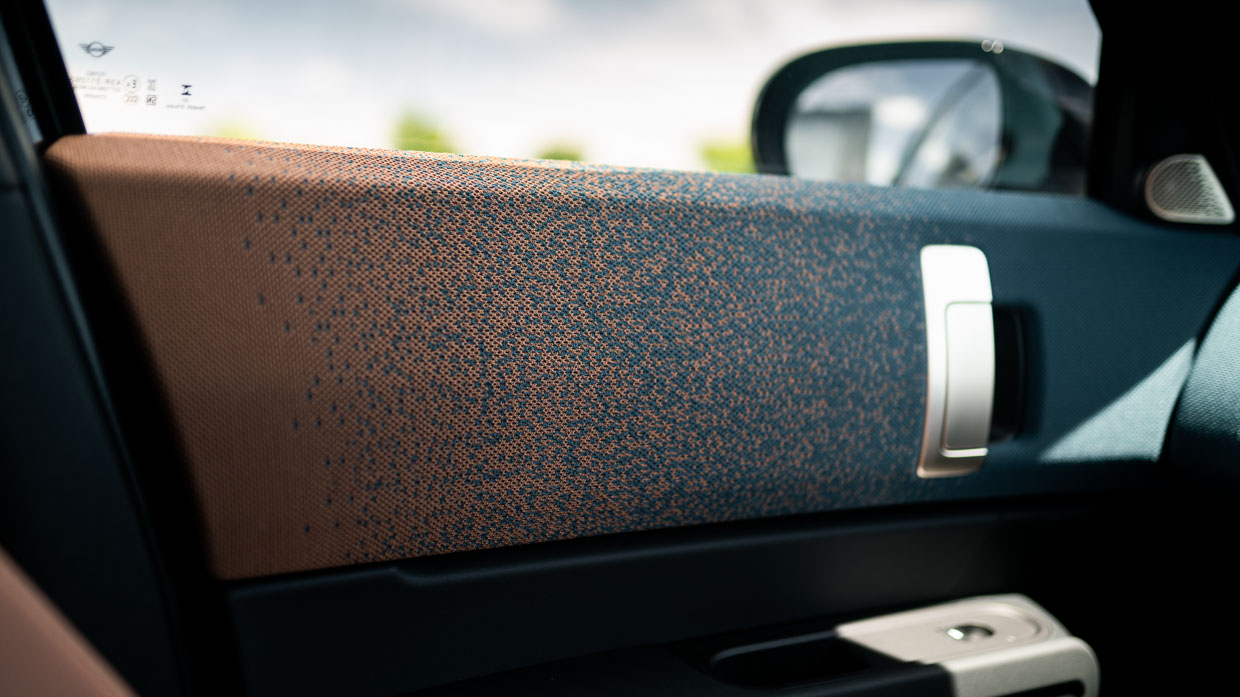
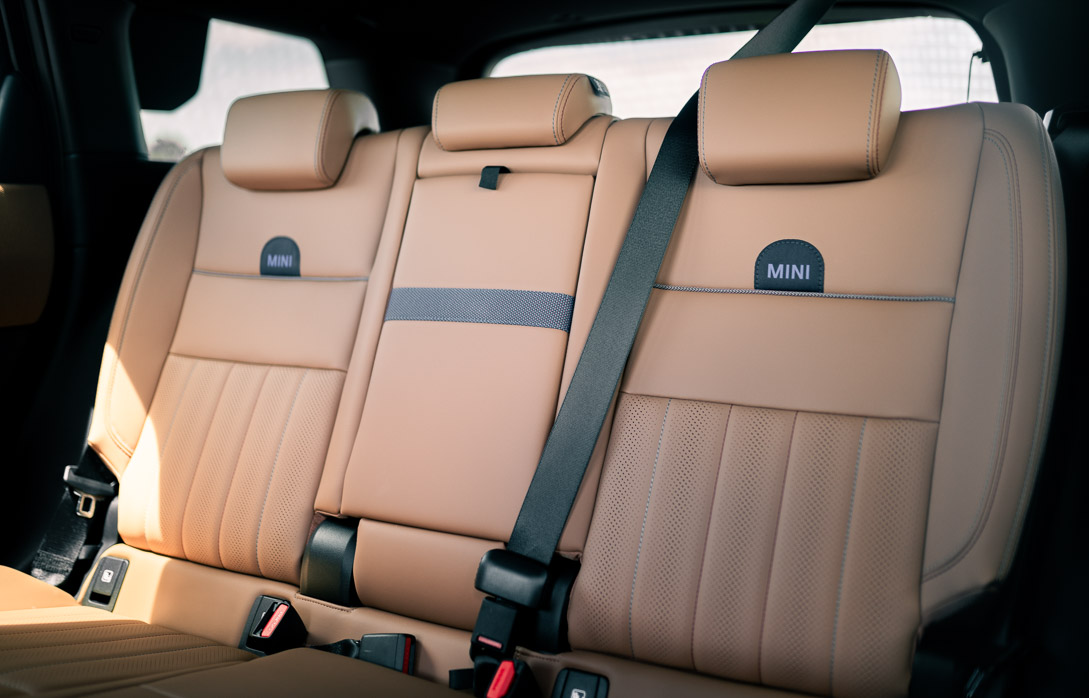
Conversely, Mini pays thoughtful attention to detail by switching on the Countryman SE’s surprisingly strong air-conditioning as soon as you open the door, and doesn’t shut it off until you close and lock the doors.
This was a real luxury when strapping the kids into a hot car that had been baking in the sun for hours; saving one from hopping in the front seat first to get the cool air pumping.
The Countryman also wins some practicality points with its boot. The rectangular 460L space swallowed a pram with ease. Additional netting is also provided to secure small items from flying around the boot.


There is no full-size or space saver spare under the floor, which is disappointing even in a typically city-based vehicle such as this one.
While many aspects of the Mini Countryman’s interior appear to put form first, it’s impressive how little these joyful touches impact function.
How does the Countryman SE drive?
The high-spec Countryman electric is quick. Quicker than you might think.
The difference between the 150kW/250Nm front-driven ‘E’ and the AWD 230kW/494Nm ‘SE’ won’t be of great consequence for some returning Countryman buyers as the former is still plenty quick when compared with petrol-engine standards.
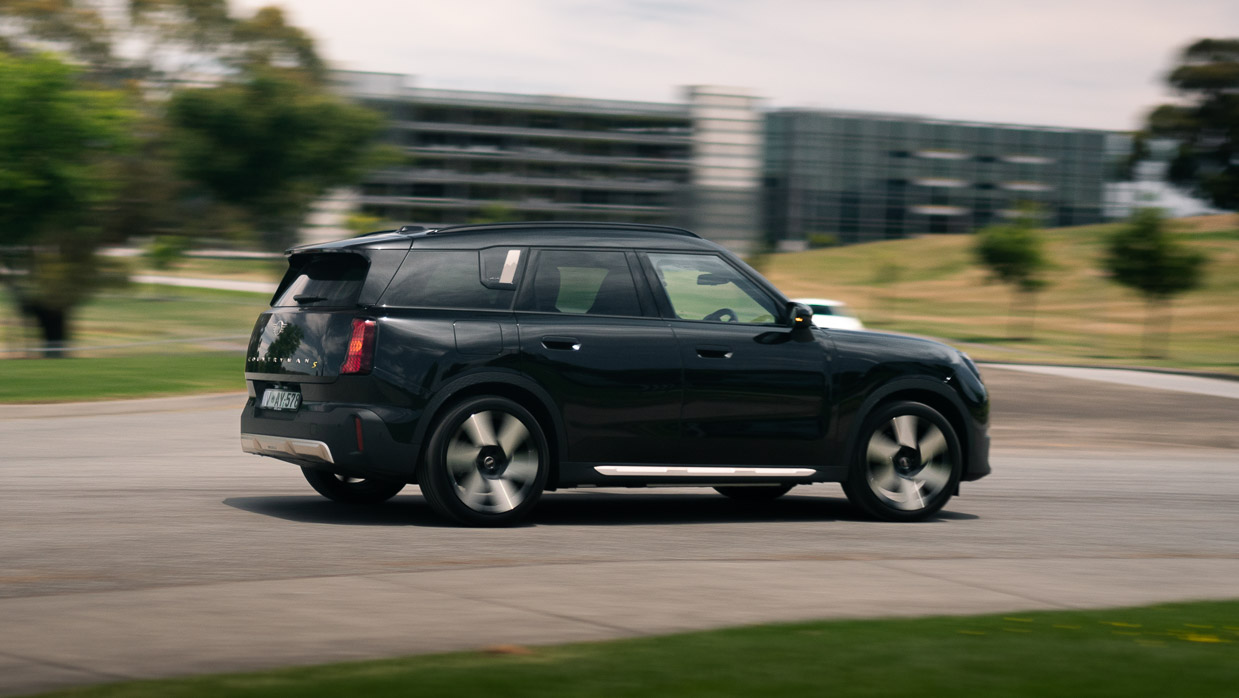
For those who do indulge in the SE, the three-second gap between the 8.6- and 5.6-second 0-100km/h time feels like a world apart, and the talent of the Countryman extends beyond straightline speed.
For a front-biased, all-wheel-drive SUV, there’s a remarkable sense of playfulness to how the Countryman SE drives, with just enough feedback and accuracy from the steering wheel to give the driver confidence to push harder in the bends on pockmarked roads.
With the Countryman scrambling out of corners in haste, it’s comforting that the strong brakes are similarly up for the task as they clamp down progressively underfoot, even if they are somewhat lacking in feel.
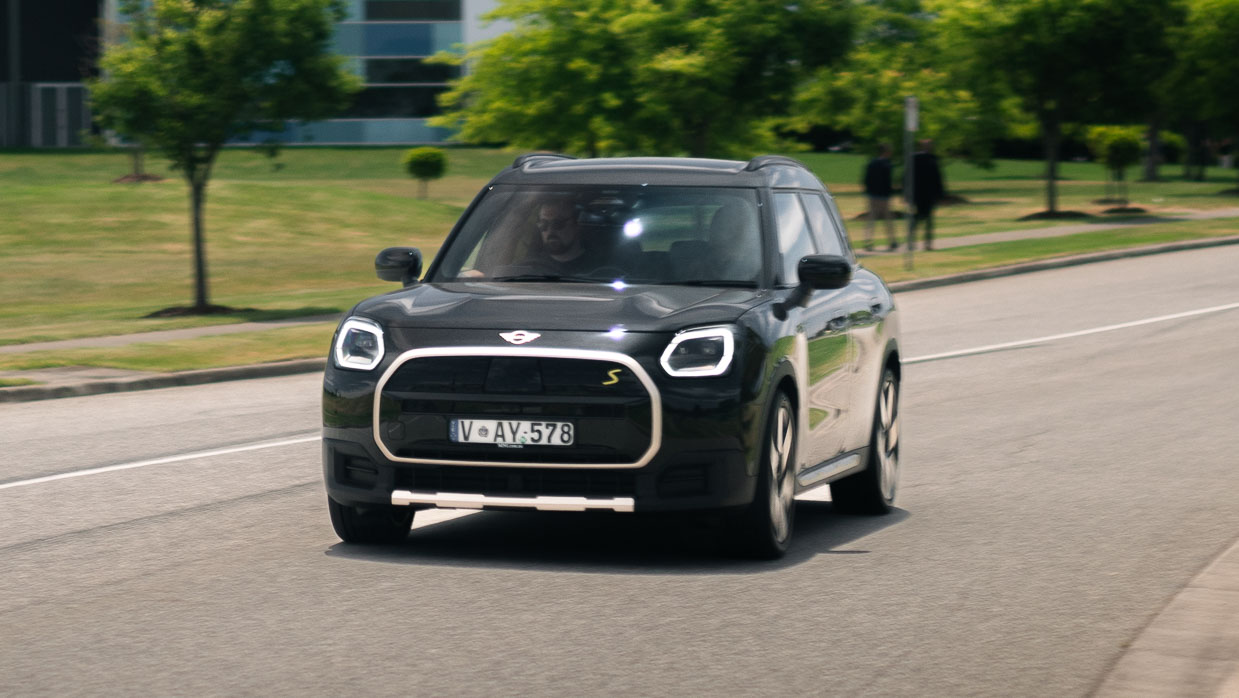
Tying it all together are Mini’s aptly named ‘Experiences’ driver profiles controlled via a toggle that sits just below the main touchscreen.
‘Go Kart’ mode is the most appropriate for hooliganism, and provides a delightful whirring noise that enhances the sense you’re being slingshot into hyperspace between one corner and the next.
The Countryman’s ride is compliant — more so than the BMW iX1 xDrive30 — and yet it retains the brand’s signature agility. It will run out of talent eventually, when its Pirelli P Zero tyres get a polite tap from its 2000kg heft, but its lateral limits are impressive.
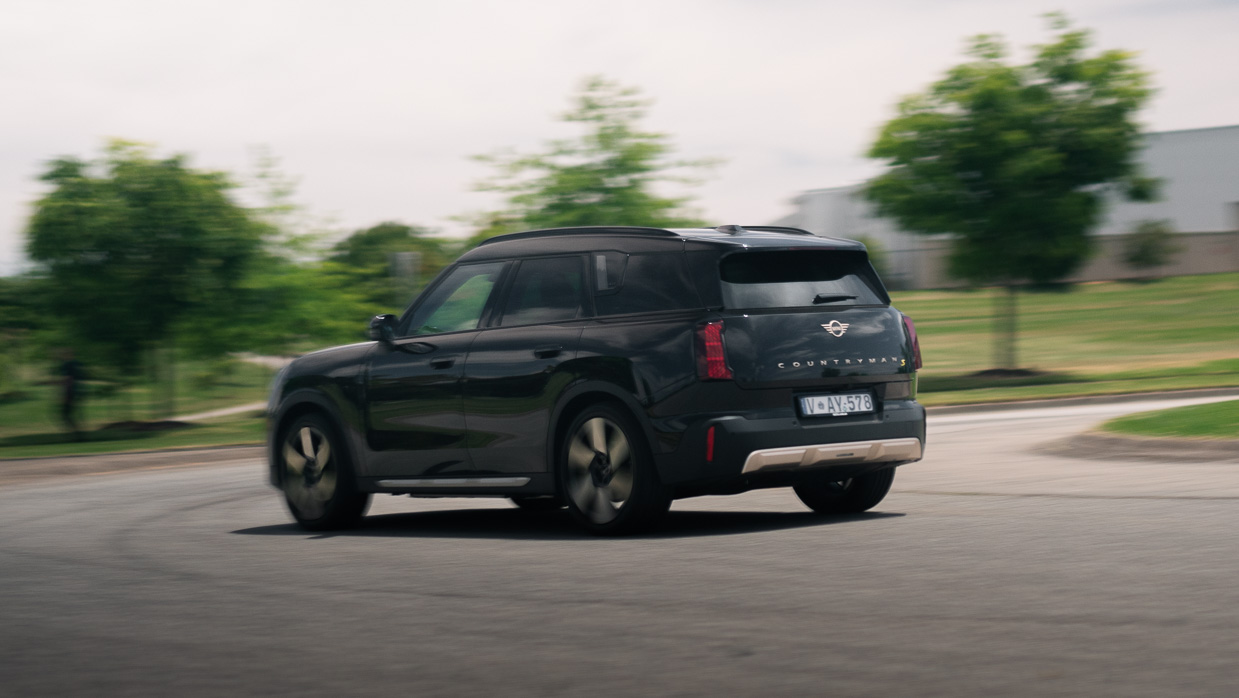
It’s a trade off that becomes worthwhile once you head in town, where small SUVs like this one do most of their driving.
Sudden potholes, pestering road-joins and sharp speed bumps are all felt inside the Countryman but they don’t crash through to your tailbone and the car itself is still small and agile enough to make avoiding obstacles a simple task.
Similarly, the Countryman is a decent highway rider for an EV, with good sound deadening and seat comfort on the odd occasion that you do want to stretch its legs, though if it’s relatively short range and lack of a spare wheel will limit its touring ability.
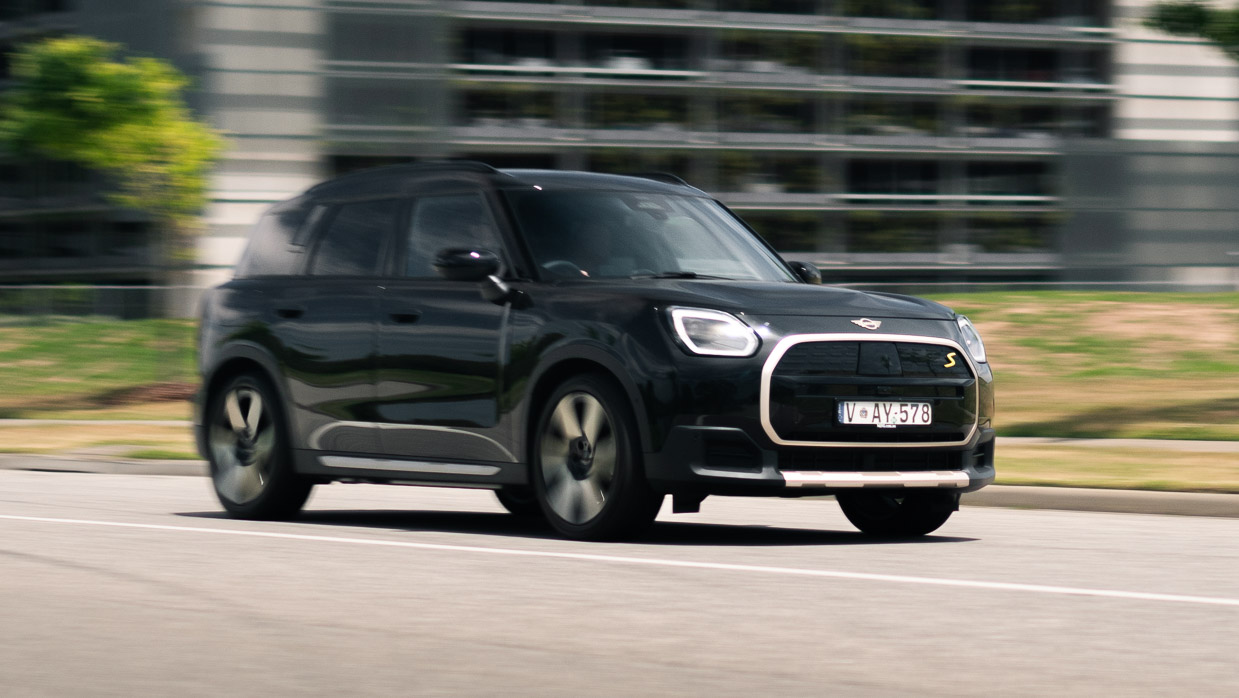
Mini offers a variety of regeneration levels for the Countryman, including a one-pedal driving mode, but the real party trick is the adaptive mode that works with the adaptive cruise control to apply as much, or as little, regeneration as needed in different circumstances.
Is the Countryman SE a safe car?
The Mini Countryman range was given a five-star rating by ANCAP in March 2024, covering both petrol and electric variants. It scored the below ratings in ANCAP’s various tests.
- 83% – Adult occupant protection
- 86% – Child occupant protection
- 81% – Vulnerable road user protection
- 83% – Safety assist
Generally speaking, yes it is a safe car; even if the on-paper subscores aren’t quite as high as its sibling in the BMW iX1 – although the Bimmer was tested under older and less strict 2022 protocols.
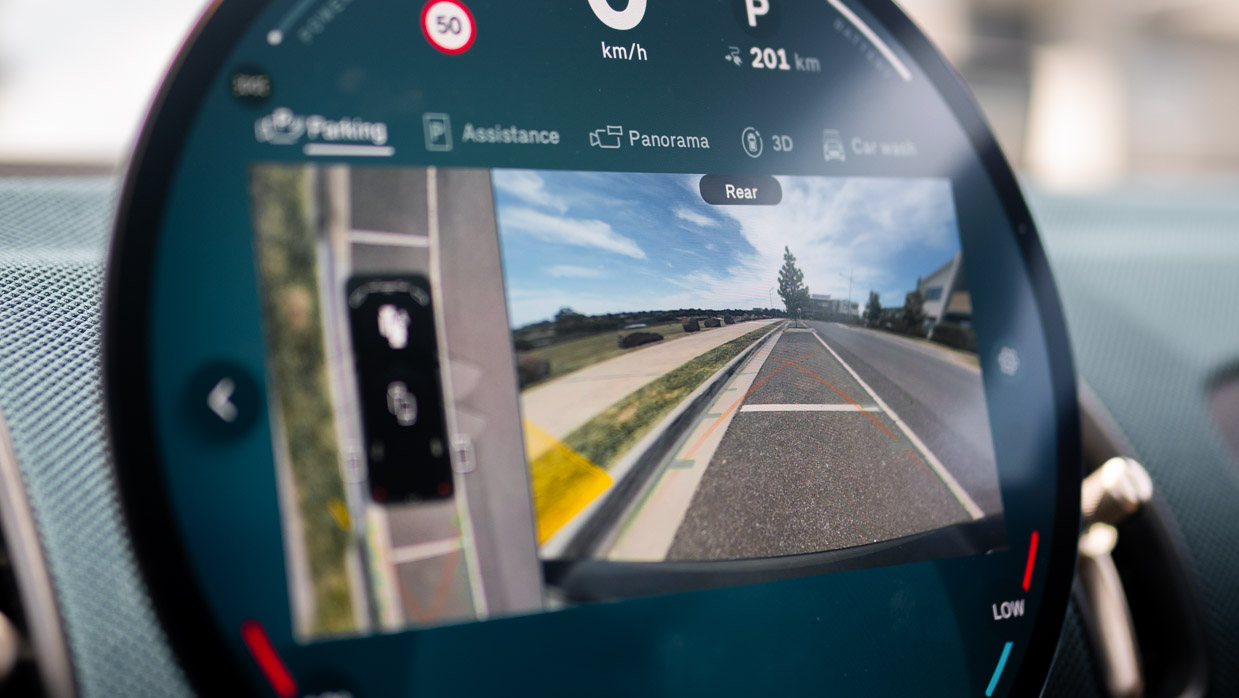
Where both the Mini and the BMW shine over newer competition from China, such as the Zeekr X, which earned remarkable scores in its 2024 test, is in the calibration of its safety equipment in the real world.
Lane-keep assist, adaptive cruise control, speed sign recognition and particularly the driver monitoring systems all offer a slick sense of implementation, to a degree that you barely notice they’re there until they kick in at the appropriate time and do so in a polite manner.
Put simply, they help not hinder, the driver.
What are the Countryman SE’s ownership costs?
The Countryman falls under Mini’s five-year, unlimited-kilometre warranty with separate eight-year/100,000km coverage on the battery and other high-voltage components.
Rather than traditional service intervals, the Countryman SE requires condition-based maintenance and will alert the driver when servicing on components, such as brakes, are required.
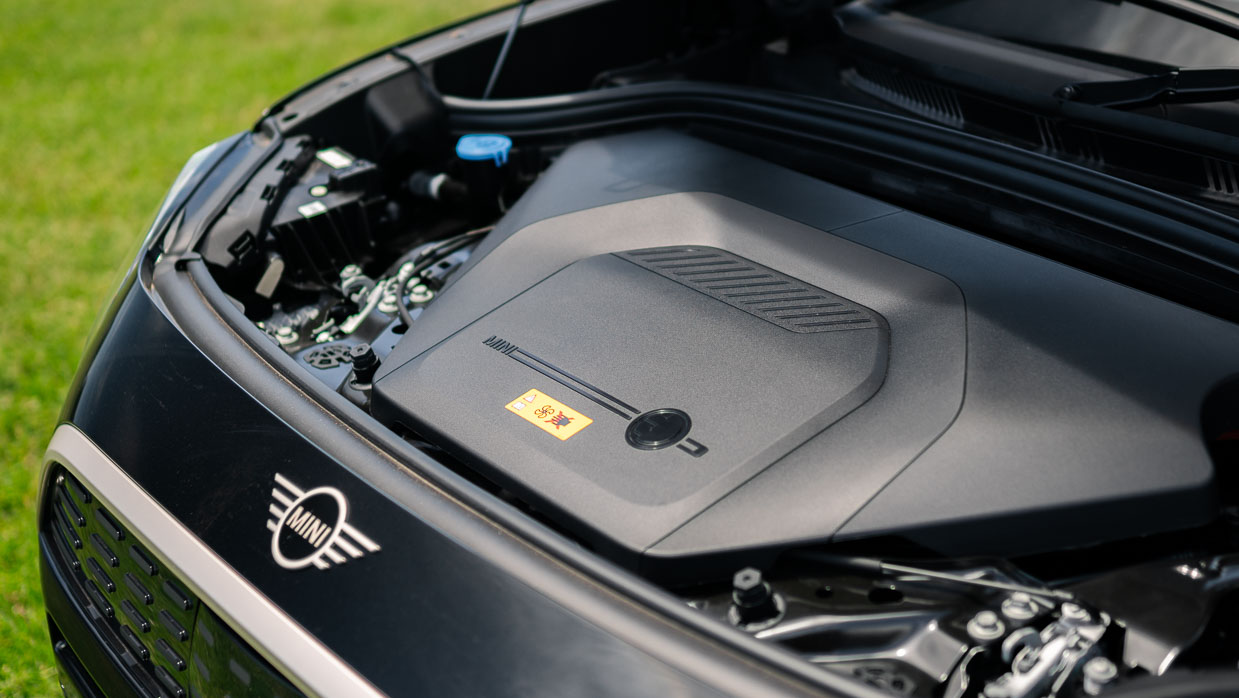
Mini offers maintenance packs in four- and six-year lengths, priced at $1500 and $2225, respectively. This covers basic maintenance and excludes brake pads and windscreen wiper replacement.
Chasing Cars conducted a highway range test in unusually hot 40+ degree weather, meaning the aircon was putting in the work to keep this motoring journalist from ending his trip medium rare.
Despite this, the Countryman clocked a quite impressive 16.1kWh/100km in terms of efficiency, indicating a range of 401km from the 64.6kWh battery. This compares to the stated range of 432km in combined conditions.
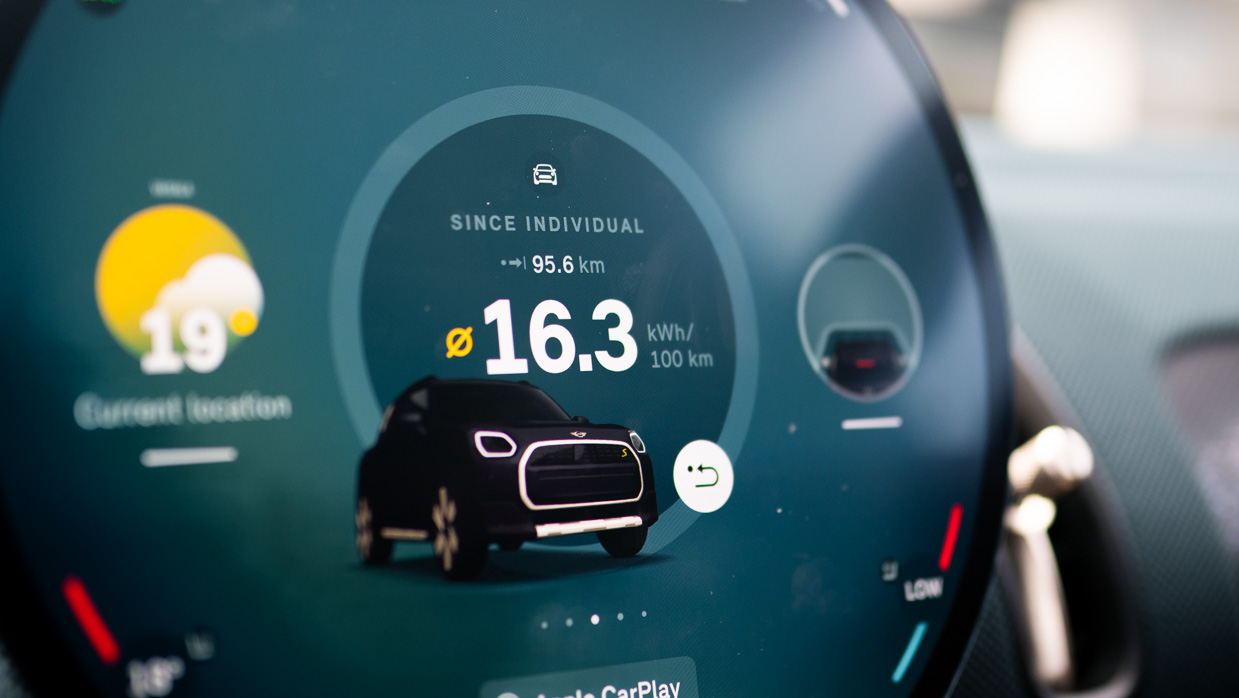
Key rivals include the BMW iX1 xDrive30 (400km), Zeekr X AWD (425km), Volvo EX30 Dual Motor (445km) and EX40 Dual Motor (485km), with only the latter offering a meaningful upgrade in outright range improvement according to the WLTP standard.
Maximum DC charging speeds are slow on paper with a peak of 130kW, but Mini still quotes a 10-80 per cent top-up time of 29 minutes, which is still plenty quick.
AC charging peaks at a more impressive 22kW, promising a flat-to-full time of three hours and 45 minutes.
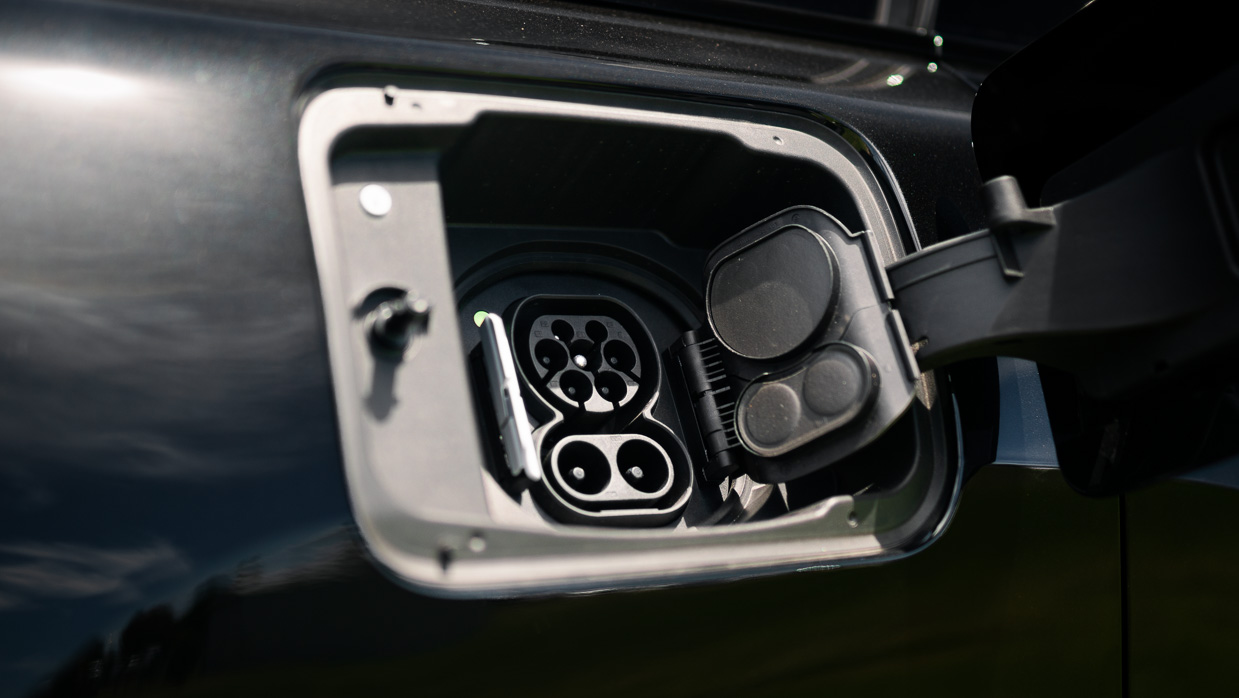
Key to note here though: having charging speeds like that at home will require seriously heavy-duty three-phase wiring to be installed.
The honest verdict on the Countryman SE
By maturing incrementally over its many generations, the attractive and practical Countryman has slipped neatly into the electric age with an air of confidence.
Keenly priced rivals from China, such as the Zeekr X and Volvo EX30, hint at a challenging future ahead for the Countryman but where the Mini pulls ahead is in the difference in execution.
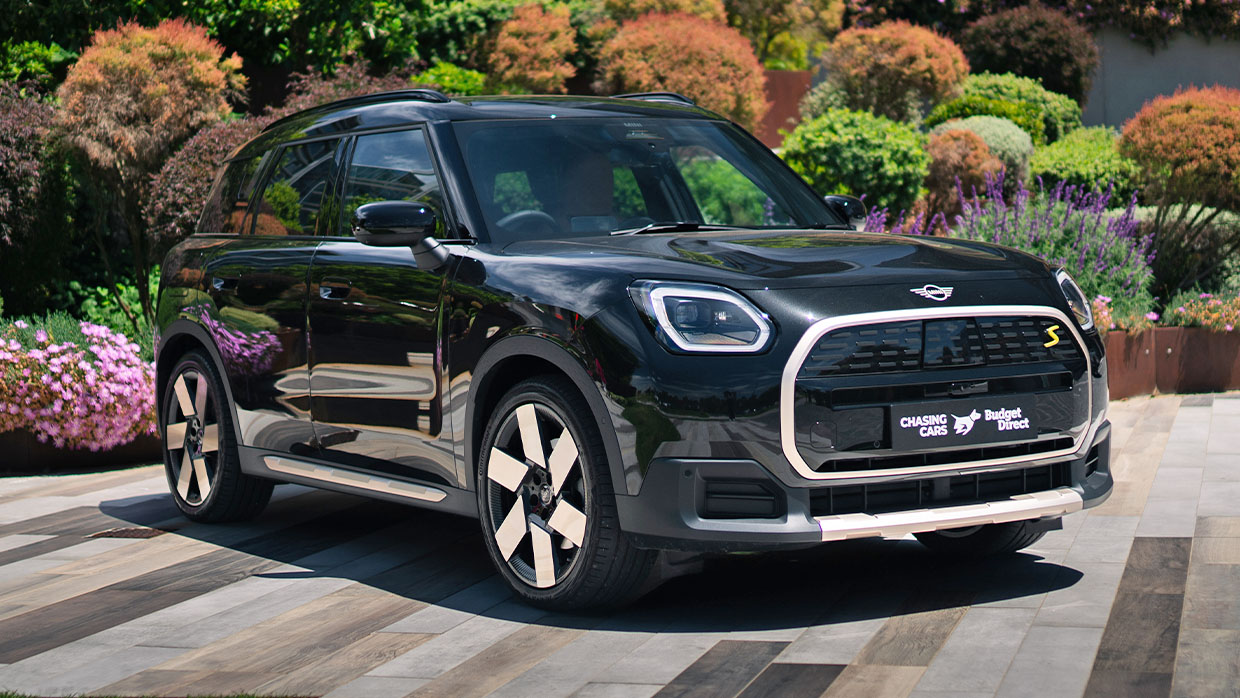
From how the suspension is calibrated through to the astute safety nannies, the Countryman consistently and confidently pulls ahead of many of its rivals, and that impressive layer of polish will make a meaningful difference to your everyday commute.
A surprisingly practical interior, relatively inoffensive price and a vivid sense of character; the Countryman SE is a vehicle we wanted to love at first sight of its lovable exterior, and by the end of our week of testing it was clear that there was substance behind the style.
BYD Sealion 5 2026: International first drive
3 months ago

John Law
Road Test Editor
Making plug-in hybrids even cheaper? The BYD Sealion 5 could arrive and change the game
Good points
- Potentially very affordable
- Well-built interior
- Solid EV stats
- Cohesive design
Needs work
- Light, vague steering
- Boot lacks features
- Ride needs work
- Could crowd BYD’s range
The big issue for plug-in hybrids from legacy brands such as Mitsubishi’s Outlanders and Ford’s defunct Escape PHEV was always price. You’d be paying $10,000 or more extra to get into these non-premium vehicles so you can have more efficiency — and so they never quite caught on.
China has arrived with lots of tech and cheap manufacturing, cutting prices of plug-in hybrids — or PHEVs — right down, below even some carmakers’ plugless self-charging hybrids. Now, BYD is mulling bringing an even more affordable midsizer Down Under in the Sealion 5.
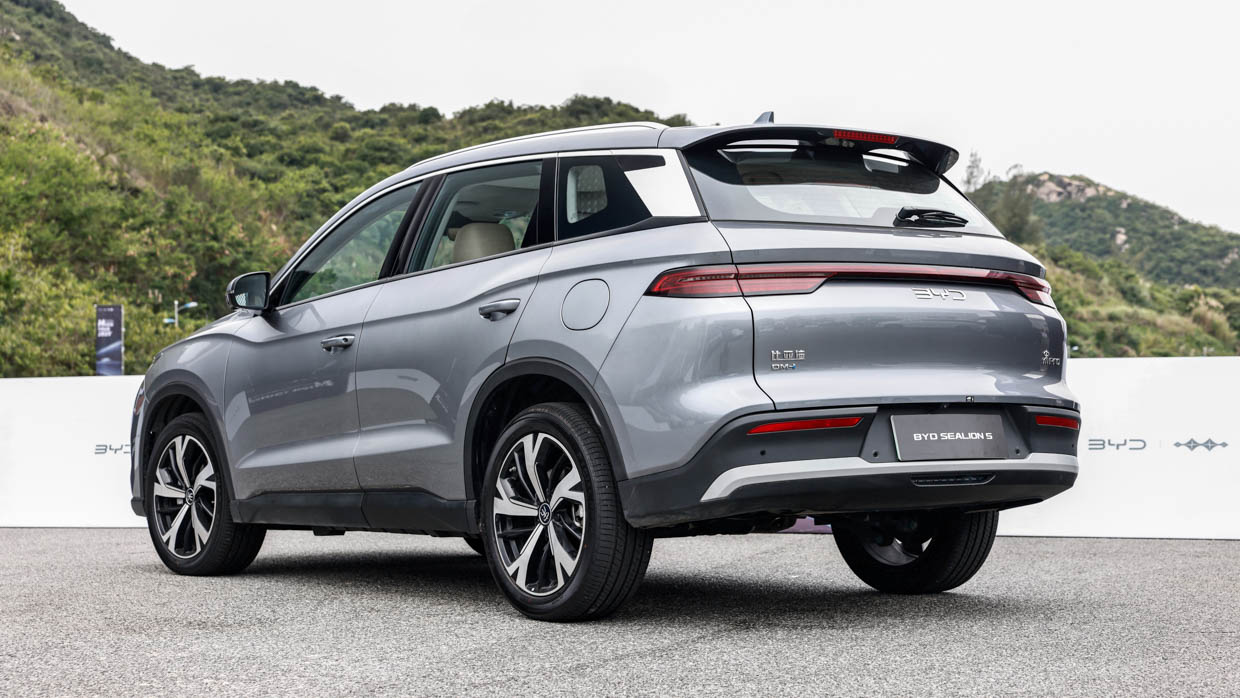
Chasing Cars spied the Sealion 5 — called the Song Pro in other markets — testing in Australia wearing blue and black camouflage, indicating the affordable midsize SUV is on the cards for local release. If it does come to Oz, it will follow the recently confirmed seven-seat Sealion 8 PHEV (or Tang L) plus the cut-price electric BYD Atto 2.
The addition of the Sealion 5 would certainly add confusion to an already crowded range. Remember, the Sealion 6 is just a little bigger than the 5, yet uses less impressive existing PHEV tech. And the Sealion 7? That’s an all-electric Tesla Model Y rival. And with the Sealion 5 about five centimetres shorter than the Sealion 6, it’s all very busy.
The Sealion 5 has a trump card: a likely sub-$40K starting price.

That’s right, a plug-in hybrid SUV with over 1300km (CLTC) driving range and 173kW able to sprint from rest to the speed limit in a little over 8.0 seconds, with wireless smartphone mirroring and a huge touchscreen for less than a parking-inspector-spec Toyota RAV4 GX.
Chasing Cars was flown to China to sample the BYD Sealion 5, along with a host of other products including the off-road-focused Denza B5. Our run-in with each car was brief but somewhat illuminating.
Naturally, the first question was of cannibalisation of Sealion 6 sales, and what the point of both models would be.
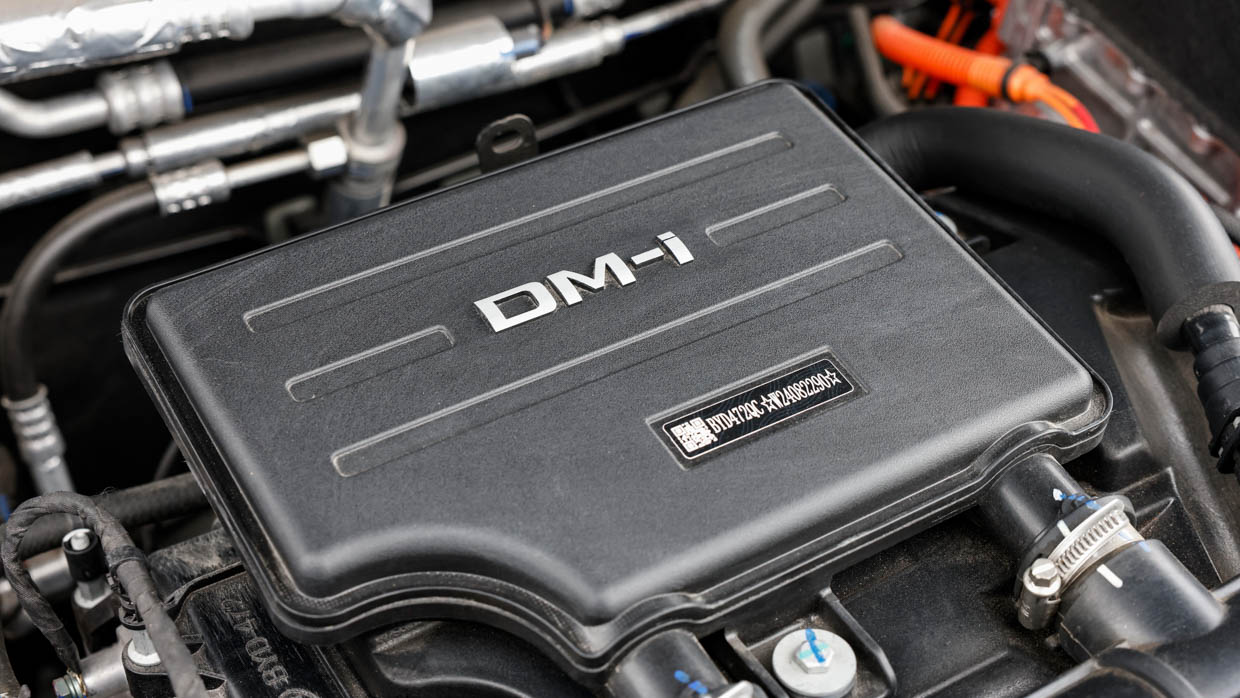
“It’s a medium-size SUV, it’s a plug-in hybrid, so definitely. I think there’s a huge love of medium-size SUVs and hybrids. [There] definitely would be good potential for [Sealion 5],” replied BYD Australia senior manager product planning and pricing Sajid Hasan.
Apart from being shorter, narrower and taller than the 6, the Sealion 5 also packs less punch, with a 74kW 1.5-litre petrol four-cylinder allied to a 120kW/210Nm electric motor for a combined 173kW. While down on the Sealion 6’s figure, it’s still up on any current Toyota RAV4.
Jumping inside revealed a cabin design that’s different to the Sealion 6, in that there’s less content, yet it was more elegant and cohesive. To hit the low price, the Sealion 5 doesn’t look like it’ll sacrifice creature comfort: heated seats, large rotating touchscreen and soft touch materials on the front and rear door tops are all present.


Choosing tan artificial leather upholstery was a good choice, as it shows off how light and airy the Sealion 5’s cabin can be, and hides the shininess of our tester’s black artificial leather. The cream alternative is even brighter.
The centre console has a single wireless charger, along with shortcut buttons for the screen. The ‘crystal’ gear selector was both nice to look at and interact with. Build quality was rather impressive — a common note in all newer BYD products.
Packaging was impressive, too, with a generously-sized rear seat and boot. The flat floor aids rear seat accommodation, while air vents were in the car we sat in along with map pockets.
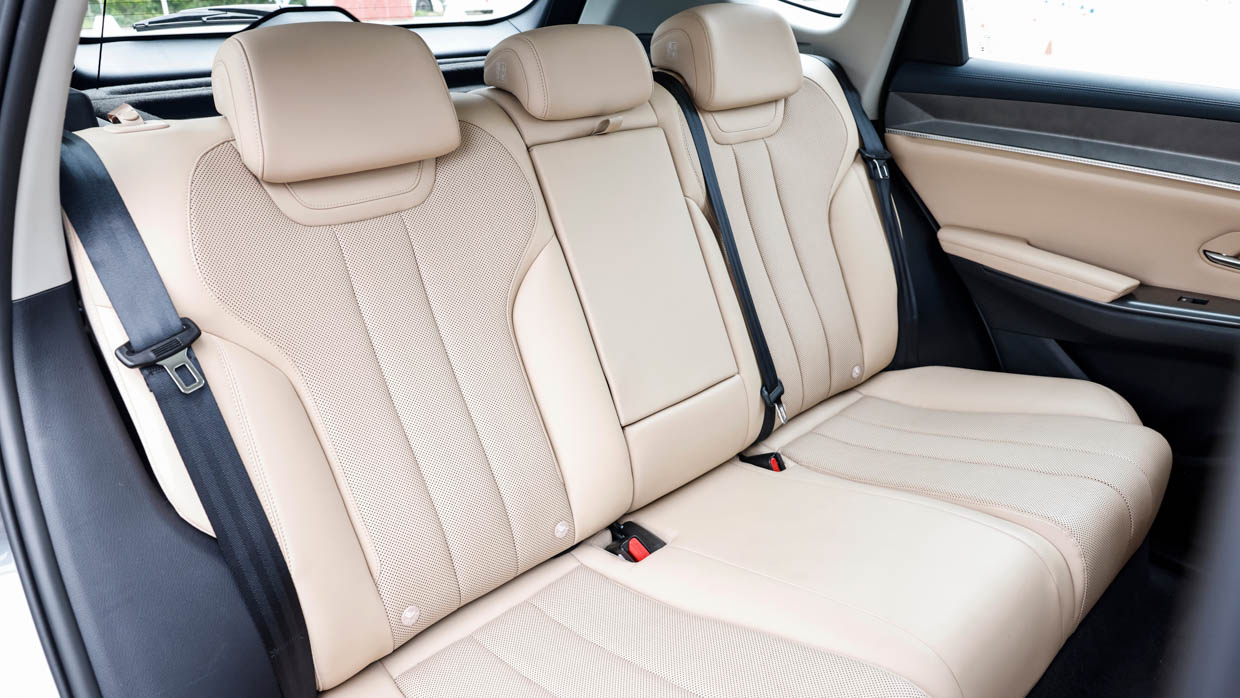
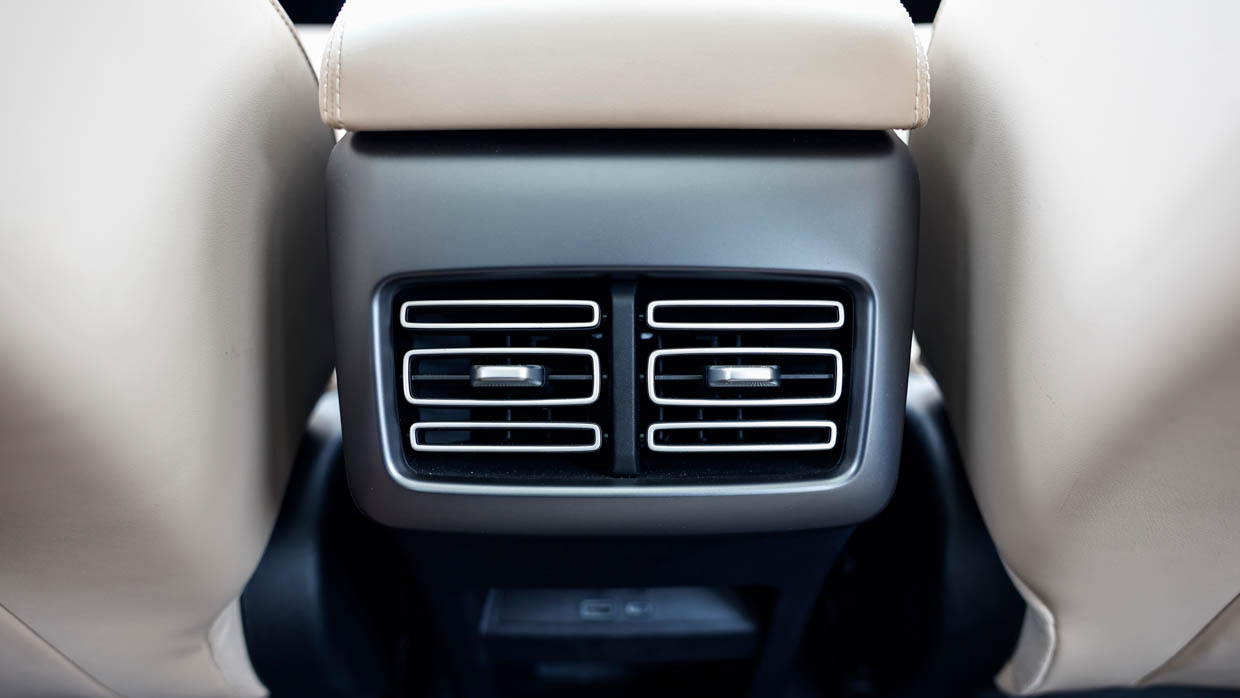
Two battery options are offered globally: a 12.9kWh for a 75 kilometres of claimed electric-only range and a larger 18.3kWh that allows 115km in electric-only mode.
Our drive of the Sealion 5 was brief, and it was the least impressive in terms of punch and suspension satisfaction, riding on simple passive dampers and steel springs with a fairly tall body.
There was a lot of body roll through a slalom test and, like the Sealion 6 in Australia, the 5 in China has featherlight controls, with easy-breezy steering.
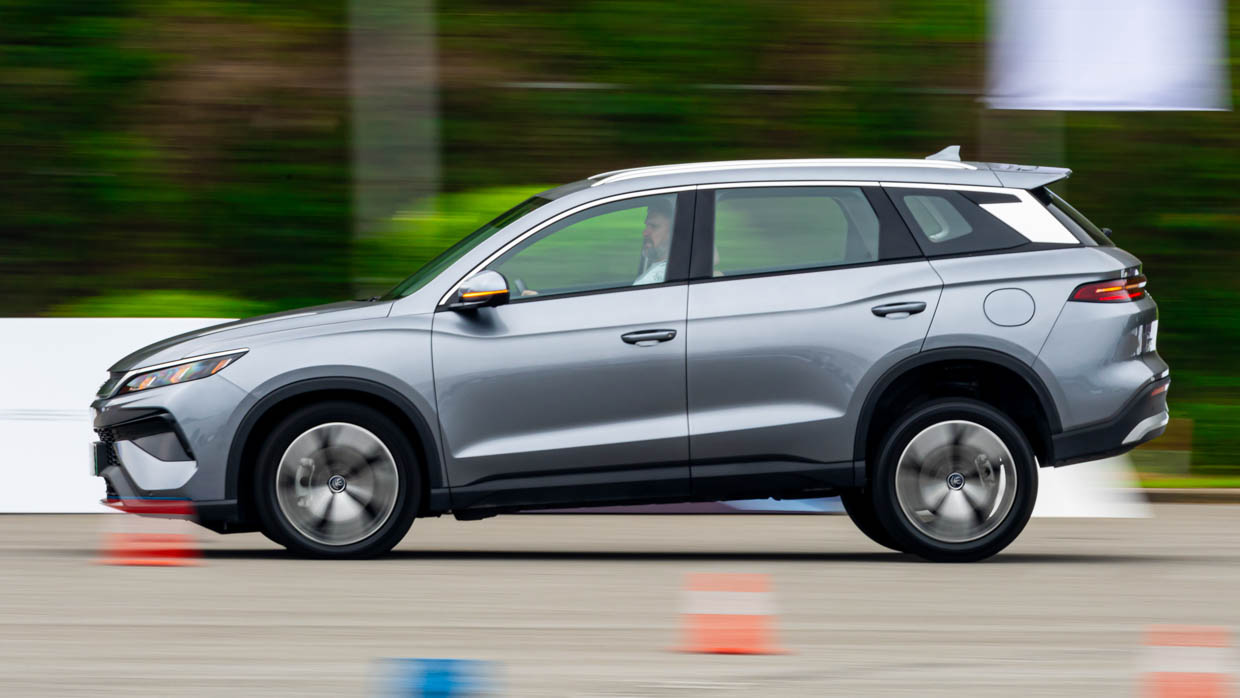
The brake pedal didn’t feel particularly positive. We also noticed a disconnect between the front and rear ends’ ability to absorb bumps.
The Sealion 5 was quiet and more than quick enough to spin up the front tyres, which is not helped by the longitudinal softness and weight transfer under acceleration (and deceleration).
It’s not likely to be the most refined and sophisticated drive experience, then, but as previous encounters with BYD’s PHEVs have proven, it’s likely to be efficient and pretty well calibrated.
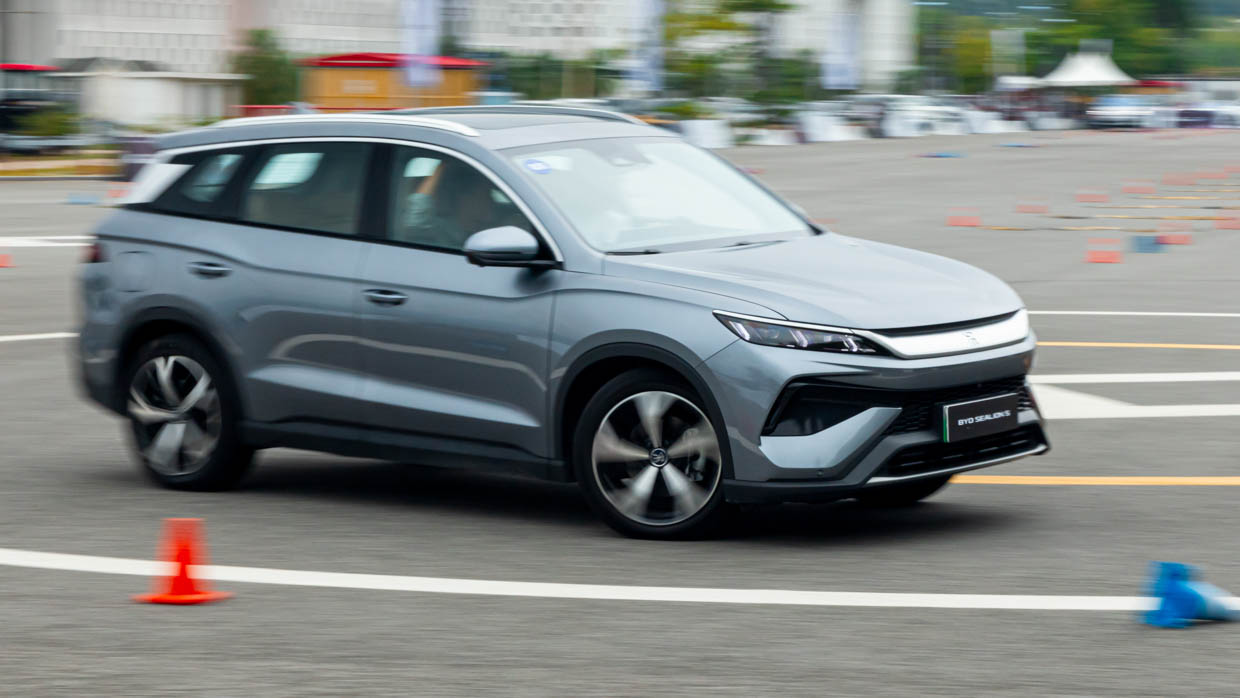
Question remains: should BYD bring it to Australia?
We asked if there was a genuine possibility the Sealion 5 will dip below $40K, before on-roads.
The answer? “We’re not too far off that already with the Sealion 6, you’re only asking for another three grand below that, so I’m sure that’s possible.”
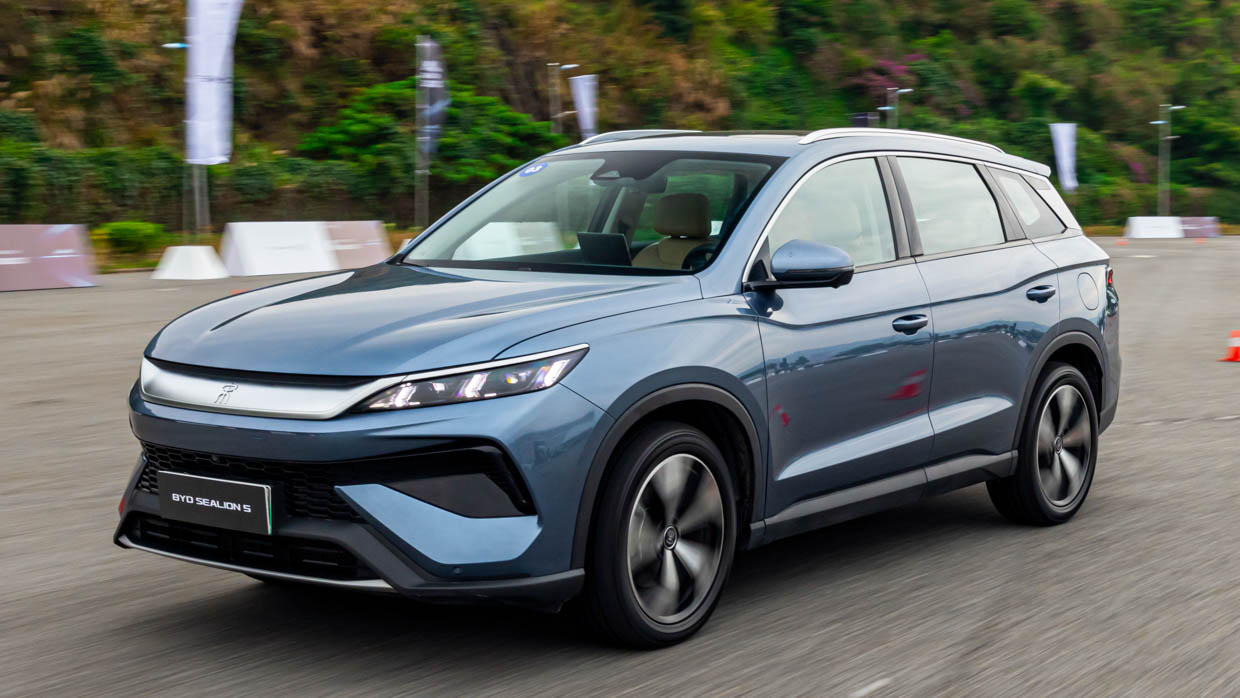
With everyday items costing more by the day, the draw of cheaper cars has seemingly never been stronger. If BYD can deliver a complete, family-friendly product for such a sharp price, then the Sealion 5 has every chance of succeeding.



